About The Johns Hopkins University. History.
Sections for Johns Hopkins University
- About The Johns Hopkins University.
- About The Johns Hopkins University. History.
- About The Johns Hopkins University. Facts And Statistics.
About The Johns Hopkins University. History.
> Johns Hopkins University Mission Statement.
The mission of The Johns Hopkins University is to educate its students and cultivate their capacity for life-long learning, to foster independent and original research, and to bring the benefits of discovery to the world.
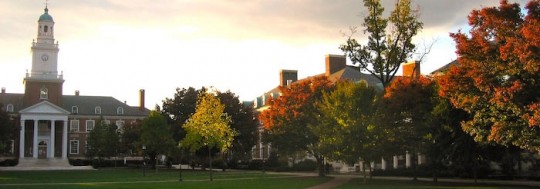
> A Brief History of JHU.
The Johns Hopkins University opened in 1876, with the inauguration of its first president, Daniel Coit Gilman. “What are we aiming at?” Gilman asked in his installation address. “The encouragement of research … and the advancement of individual scholars, who by their excellence will advance the sciences they pursue, and the society where they dwell.”
The mission laid out by Gilman remains the university’s mission today, summed up in a simple but powerful restatement of Gilman’s own words: “Knowledge for the world.”
What Gilman created was a research university, dedicated to advancing both students’ knowledge and the state of human knowledge through research and scholarship. Gilman believed that teaching and research are interdependent, that success in one depends on success in the other. A modern university, he believed, must do both well. The realization of Gilman’s philosophy at Johns Hopkins, and at other institutions that later attracted Johns Hopkins-trained scholars, revolutionized higher education in America, leading to the research university system as it exists today.
After more than 130 years, Johns Hopkins remains a world leader in both teaching and research. Eminent professors mentor top students in the arts and music, the humanities, the social and natural sciences, engineering, international studies, education, business and the health professions. Those same faculty members, and their research colleagues at the university’s Applied Physics Laboratory, have each year since 1979 won Johns Hopkins more federal research and development funding than any other university.
The university has nine academic divisions and campuses throughout the Baltimore-Washington area. The Krieger School of Arts and Sciences, the Whiting School of Engineering, the School of Education and the Carey Business School are based at the Homewood campus in northern Baltimore. The schools of Medicine, Public Health, and Nursing share a campus in east Baltimore with The Johns Hopkins Hospital. The Peabody Institute, a leading professional school of music, is located on Mount Vernon Place in downtown Baltimore. The Paul H. Nitze School of Advanced International Studies is located in Washington’s Dupont Circle area.
The Applied Physics Laboratory is a division of the university co-equal to the nine schools, but with a non-academic, research-based mission. APL, located between Baltimore and Washington, supports national security and also pursues space science, exploration of the Solar System and other civilian research and development.
Johns Hopkins also has a campus near Rockville in Montgomery County, Md., and has academic facilities in Nanjing, China, and in Bologna, Italy. It maintains a network of continuing education facilities throughout the Baltimore-Washington region, including centers in downtown Baltimore, in downtown Washington and in Columbia.
When considered in partnership with its sister institution, the Johns Hopkins Hospital and Health System, the university is Maryland’s largest employer and contributes more than $10 billion a year to the state’s economy.

> Who Was Johns Hopkins
First things first: why the extra “S”? Because his first name was really a last name.
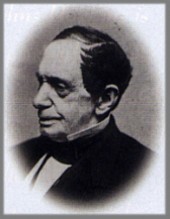
Johns Hopkins’ great-grandmother was Margaret Johns, the daughter of Richard Johns, owner of a 4,000-acre estate in Calvert County, Md. Margaret Johns married Gerard Hopkins in 1700; one of their children was named Johns Hopkins.
The second Johns Hopkins, grandson of the first, was born in 1795 on his family’s tobacco plantation in southern Maryland. His formal education ended in 1807, when his parents, devout Quakers, decided on the basis of religious conviction to free their slaves and put Johns and his brother to work in the fields. Johns left home at 17 for Baltimore and a job in business with an uncle, then established his own mercantile house at the age of 24.
He was an important investor in the nation’s first major railroad, the Baltimore and Ohio, and became a director in 1847 and chairman of its finance committee in 1855.
Hopkins never married; he may have been influenced in planning for his estate by a friend, philanthropist George Peabody, who had founded the Peabody Institute in Baltimore in 1857.
In 1867, Hopkins arranged for the incorporation of The Johns Hopkins University and The Johns Hopkins Hospital, and for the appointment of a 12-member board of trustees for each. He died on Christmas Eve 1873, leaving $7 million to be divided equally between the two institutions. It was, at the time, the largest philanthropic bequest in U.S. history.

> Inaugural Address of Daniel Coit Gilman as first president of The Johns Hopkins University.
Daniel Coit Gilman was inaugurated as the first president of The Johns Hopkins University on Tuesday, Feb. 22, 1876, in the Academy of Music at Howard and Centre Streets in downtown Baltimore. Among the distinguished guests were the governor of Maryland, the mayor of Baltimore and representatives of a number of colleges and universities, including President Eliot of Harvard. The significance of the occasion was clearly stated by Reverdy Johnston Jr., chairman of the executive committee of the new university’s Board of Trustees, in his presentation of the new president. “We may say that the university s birth takes place today, and I do not think it mere sentiment should we dwell with interest upon its concurrence with the centennial year of our national birth, and the birthday of him who led the nation from the throes of battle to maturity and peace.” At 45, Daniel Coit Gilman then stepped to the podium to deliver his inaugural address, which was to set the tone for American higher education for the century to come.
If this assembly, with one voice, could utter the thought now uppermost, there would be a deep, quick, hearty acknowledgment of the bounty of Johns Hopkins.
His beneficence, so free, so great, so wise, promoting at once the physical, intellectual and moral welfare of his fellow-men, awakens universal surprise and admiration, and calls for our perpetual thanks.
In respect to the giver, I can say but little to you, the citizens of Baltimore, who knew him so well; who remember his industry, sagacity and intellectual force; who have tested his integrity, and found that his word was as good as his bond; who recall his foresight, his enterprise, and his belief in the future of this city and state; who recollect that more than once in financial crises he hazarded his own fortune for the protection of others; who heard, it may be from his own lips, the motives and hopes which prompted these royal gifts; who believe that great acquisitions involve great responsibilities, but who know how hard it was for one long accustomed to power to yield that power to others; to you, his fellow-citizens, who saw the steps by which this benefactor toiled upward to the temple of Fortune, and there unsatisfied, went higher, by more arduous steps, to the temple of Charity, where he bestowed his gifts.
While I leave to others the commemoration of our founder, you must let me refer to the tributes of admiration which his generosity has called out on the remotest shores of our own land, and in the most venerable shrines of European learning. The Berkeley laurel and the Oxford ivy may well be carved upon his brow when the sculptor shapes his likeness; for by wise men in the east and by rich men in the west, his gifts are praised as among the most timely, the most generous, and the most noble ever bestowed by one, for all.
The genesis of American munificence is a bright chapter of our history. From the days of the Puritan minister, who gave his name to our oldest University, and the days of the London merchant, who endowed the second college in New England, each generation has surpassed its predecessors. It is a striking coincidence that among the very earliest names on. this heraldic roll, is that which our foundation bears. The schools which Edward Hopkins, a colonial governor, established in 166o, by his will, and his gifts to Harvard, still keep alive his name and influence. So may the name of our founder live for more than two hundred years to come, and his gifts be immortal. Johns Hopkins might have used the very words of Edward Hopkins, who desired to bestow “some encouragement for the breeding up of hopeful youths, for the public service of the country in future times.”
We may conjecture a spiritual if not a physical descent in the line of Hopkins. In 1676, the name is written on the door of an endowed grammar school at New Haven, older than Yale, and second only to Harvard; in 1776, the name is signed to the Declaration of Independence; in 1876, it distinguishes a University Foundation. To our contemporary, we may apply the words with which the deeds of the colonial governor are recounted. After saying that his last will is an interesting monument of private friendship and public spirit, that friends and domestics were not forgotten, that his public gifts were “for the promotion of religion, science and charity,” the historian adds this eulogy: “Thus did this lofty and intellectual spirit devise and distribute blessings in his own age, and by his wisdom, prepare and make them perpetual for succeeding times.”
The Endowment
The total amount of the public gifts of Johns Hopkins, is more than seven million dollars. The sum of $3,500,000 is appropriated to a university; a like sum to a hospital; and the rest to local institutions of education and charity. Let us compare these benefactions with some others. Thirty years ago, when the gift of Abbott Lawrence to Harvard College was made known it was said to be “the largest amount ever given at one time during the life time of the donor to any public institution in this country,” — the amount was $50,000; the gift of Smithson, so well administered in Washington, amounted to over half a million; the foundation of Stephen Girard surpassed two million dollars.
You may see from these figures what great munificence has brought us together. So far as I can learn, the Hopkins foundation, coming from a single giver, is without a parallel in terms or in amount in this or any land. But beware of exaggeration. These gifts are often spoken of as if the whole, instead of the half, was intended for the university, and then as if an equal amount was given to the hospital; and so it happens that dreams of monumental structures and splendid piles and munificent salaries flit through the mind which can never become real. Do not forget how much wealth is accumulated by older colleges — in repute, experience and influence, and also in material things. The property of Harvard College is more than five million dollars; that of Yale must equal our endowment. The land investments of a university in the Northwest are said to exceed these values; and Ezra Cornell, while he lived, expected that the endowments at Ithaca would approach, if not surpass, the funds of Harvard. The income yielding funds of Harvard in 1875 were over three million; those of Yale near a million and a half. Even these figures look small compared with the accumulations of Oxford and Cambridge.
Now turn our capital into income. Our university fund yields a revenue of nearly $200,000. Let us compare this amount with the resources of our two richest colleges. Harvard, in 1874-5, (in all departments), received from tuition $168,541.72; from property, $218,715.30; a total of $387,257.02. The college alone, not including the library, the general administration, or any of the special departments, cost $187,713.20, which is nearly our whole income. Yale College reports its academical expenses (i.e., exclusive of those in the scientific, theological, law, medical and art departments), in 1874-5, as $126,073.56.
But all our revenue is not at once available; for, as the capital cannot be spent for buildings, some income must be reserved for this. Of course, the buildings will be good and costly. If now we deduct from our income, as a building fund, one hundred thousand dollars annually, it will take several years to accumulate the requisite amount. Of that which remains a large sum will be absorbed by taxation, administration and the purchase of books, instruments and collections. Thus it is evident that the educational income at present is not large. Its expenditure requires great discretion and prudence. The trustees are men of liberal views in respect to professional salaries, but they see as clearly as a schoolboy sees through a problem in short division that the larger the divisor, the less the quotient; the more salary, the less chairs; the more eminent and costly the teachers, the fewer can be secured. I wish that every one who sees the need of a great university, and who knows the range of human science, would take a pencil and distribute our income in the departments which he would like to see promoted here. If his experience is like mine, he will find that before his pencil has half gone down the column of sciences, the income has been twice expended.
I fear that these remarks are a little ungracious, and I would gladly repress them; but the private and public utterances of thoughtful men have been so vague as to what it is possible for the trustees of this university to accomplish at once, and our friends are so very generous in their expectations that I feel compelled, at the very outset, to utter a word of caution. If our physicists could bring us “Aladdin s lamp,” or our chemists produce “the philosopher s stone,” or our merchants give us “the widow s cruse,” our aspirations should not be checked by our restricted means; but, till the original benefaction is supplemented by other gifts, or the growth of Baltimore increases the value of our present investments, we must be contented with good work in a limited field.
Its Five-Fold Advantages
To many the magnitude of our founder s bounty seems its principal value; that is, in fact, but half its glory. With a self-renunciation which is rare and noble, he attached to the gift no burdensome condition or personal whim. The almoners of his bounty are restrained by no shackles bequeathed by a departed benefactor, as they enter upon their course bearing in the one hand the ointment of charity and in the other the lamp of science. His trustees are free — free to determine principles, to decide upon methods, to distribute income, to select professors, to summon students, and even to alter, from time to time, their own plans — as the enlightenment of the world bestows its radiance upon their undertaking.
In selecting trustees the choice of our founder fell upon those of his friends and acquaintances whom he believed would be free from a desire to promote, in their official action, the special tenets of any denomination or the platform of any political party In a land where almost every strong institution of learning is either “a child of the church” or “a child of the state,” and is thus liable to political or ecclesiastical control, he has planted the germ of a university which will doubtless serve both church and state the better because it is free from the guardianship of either. It was his wish — it is our wish — that here should be a seat of learning so attractive that at its threshold students would gladly cease to discuss sectarian animosities and political prejudices, in their eagerness for the acquisition of Knowledge and their search for Eternal Truth. As in olden time the courtier s and the peasant s sons laid aside their distinctive costumes when they donned the academic dress, let us hope that here the only badges will be those which mark the scholar.
Another advantage attends our foundation. It is established in a large town, in an old state, near to the financial and the political Capitals of the Republic; and at the junction of national highways which connect the North and the South, the East and the West. This is in fact a metropolis or middle city. Such geographical considerations will surely affect our future. Baltimore, moreover, is prepared for this foundation. Professional schools of law, medicine and theology already attract large numbers of students. Technical instruction in the useful arts is to some extent provided in the Maryland Institute. The votaries of the natural sciences are associated in an Academy, which only needs an endowment to enable it to take rank with kindred societies else-where. The city, with a liberality which is praised at home and abroad, maintains two excellent high schools for young ladies, and for young men a City College, so well organized, so well taught and so well supported, that it relieves our foundation of doing much which is called “collegiate” in distinction from “university” work. There are good private schools. There are excellent collections of paintings and rare opportunities for the study of music, both as a science and an art. More than all this the foundation of George Peabody, in which a capital of a million and a quarter of dollars is forever set apart for the pro- motion of culture, has now, with increasing strength, survived the perils of infancy, and gained a place among the very best establishments to be found in any part of our land. Its library is extraordinary for our country; not because of its size, (some 60,000 volumes) but because it has been selected with an experienced eye, among the most modern and most useful of the publications of the world.
The advantage which will come to the new University in its medical department from the establishment of a hospital, on a separate but allied foundation, is most obvious. Obvious though it is, the most enlightened can not over-estimate its value. If so large a sum as the hospital fund ($3,500,000) were consecrated under any circumstances to the relief of suffering, the promotion of health, and the preservation of life — humanity would rejoice; but when such a foundation is connected with a university, so that on the one hand it commands all the resources of human learning, and on the other makes known through accomplished teachers the results of its experience, we may confidently expect that its influence for good will be more than doubled; that its immediate work in the care of the sick and wounded will be better done than would otherwise be possible; and that its remedial and preventive agencies will extend to thousands who may never come within its walls, but whose ills will be relieved by those taught here.
The timeliness of our foundation is the last of the advantages which I shall name. We begin our work after discussions lasting for a generation respecting the aims, methods, deficiencies, and possibilities of higher education in this country; after numerous experiments, some with oil in the lamps and some without; after costly ventures of which we reap the lessons, while others bear the loss; after Jefferson, Nott, Wayland, Quincy, Agassiz, Tappan, Mark Hopkins, Woolsey, have completed their official services and have given us their supreme decisions; while the strong successors of these strong men, Eliot, Porter, Barnard, White, Angell and McCosh, are still up on the controversial platform; we begin after the national bounty has for fourteen years, under the far-reaching bill of Senator Morrill of Vermont, promoted scientific education; and after scores of wealthy men have bestowed many million dollars for the foundation of new institutions of the highest sort.
Discussions Elsewhere
Educational discussions and movements are not restricted to our new country. In old England, questions like these are constantly rife, (in addition to many of purely local interest): How may professorships in the old universities be restored to the dignity or influence, of which they have been in part deprived by the excessive preponderance of collegiate instruction; how may the university influences be extended to all the large towns; how may science gain a more generous recognition in the ancient seats of learning; how may endowments for research be established without leading to sinecure fellowships; how may ecclesiastical fetters be removed from academic institutions; how may the universities, by their systems of local examinations, best promote the welfare of the preparatory schools, or the training of young persons who are not likely to enter the university; how may the university better provide for the innumerable modern callings, which lie outside of the old “professions” but require an equal culture.
In France, there has not been since the Revolution, I presume, such interest in the promotion of universities as now. I pronounce no opinions, but I call attention to the remarkable law which was passed last year, relinquishing the exclusiveness of a State foundation, and declaring university instruction to be free. Those who have hitherto been oppressed, as they have thought, by a hard law, now seize with alacrity the opportunity to found new institutions, and the offerings of the faithful are freely poured out to restore to the Church those intellectual agencies from which she has been cut off.
At a distance, Germany seems the one country where educational problems are determined; not so, on a nearer look. The thoroughness of the German mind, its desire for perfection in every detail, and its philosophical aptitudes are well illustrated by the controversies now in vogue in the land of universities. In following, as we are prone to do in educational matters, the example of Germany, we must beware lest we accept what is their cast off; lest we introduce faults as well as virtues, defects with excellence. Some of the ablest men in the new empire I are now questioning whether “the Real School” system, after a trial of so many years, is justified of its works — and whether “the gymnasium,” somewhat modified, should not be the training place of all who seek a higher culture. Others are questioning whether it is not a mistake to maintain polytechnic schools, and special schools of agriculture, forestry, mining, etc., apart from the universities; and whether it would not be better to combine the higher educational foundations under one direction and in one centre. Some of the best scientific men declare their belief that the university instruction in science, following the gymnastic discipline, is better far as a preparation for what are called the modern pursuits, than the training which is given by the Real school and the Polytechnic, and so they assert that an exaggerated value has been attached to technical training.
I only allude to these discussions in passing. It would take many hours to unfold them. But it is well to bear in mind that the most enlightened institutions in our country, and the most enlightened countries in Europe, are those in which educational discussions are now most lively; and it behooves us, as we engage in a new undertaking, to listen, ponder, and observe; and above all to be modest in the announcement of our plans. It should make the authorities cautious in offering, and the public cautious in demanding a completed scheme for the establishment of a university in Baltimore.
Our caution is none the less needed when we remember that at the present moment Americans are engaged in promoting the institutions of higher education in Tokyo, Peking and Beirout, in Egypt and the Hawaiian Isles. The oldest and the remotest nations are looking here for light. W7hat is the significance of all this activity? It is a reaching out for a better state of society than now exists; it is a dim but an indelible impression of the value of learning; it is a craving for intellectual and moral growth; it is a longing to interpret the laws of creation; it means a wish for less misery among the poor, less ignorance in schools, less bigotry in the temple, less suffering in the hospital, less fraud in business, less folly in politics; it means more study of nature, more love of art, more lessons from history, more security in property, more health in cities, more virtue in the country, more wisdom in legislation, more intelligence, more happiness, more religion.
The Higher Education
The institutions which are founded in modern society for the promotion of superior education may be grouped in five classes: 1, UNIVERSITIES; 2, LEARNED SOCIETIES; 3, COLLEGES; 4, TECHNICAL SCHOOLS; and 5, MUSEUMS, (including literary and scientific collections). It is important that the fundamental ideas of these various institutions should be borne in mind.
The University is a place for the advanced special education of youth who have been prepared for its freedom by the discipline of a lower school. Its form varies in different countries. Oxford and Cambridge universities, are quite unlike the Scotch, and still more unlike the Queen s University in Ireland; the University of France has no counterpart in Germany; the typical German universities differ much from one another. But while forms and methods vary, the freedom to investigate, the obligation to teach, and the careful bestowal of academic honors are always understood to be among the university functions. The pupils are supposed to be wise enough to select, and mature enough to follow the courses they pursue.
The Academy, or Learned Society, of which the Institute of France, with its five academies, and the Royal Society of London, are typical examples — is an association of learned men, selected for their real or reputed merits, who assemble for mutual instruction and attrition, and who publish from time to time the papers they have received and the proceedings in which they have engaged. The University is also an association of learned men, but the bond which holds them together differs essentially from that of the academy. In the universities teaching is essential, research important; in academies of science research is indispensable, tuition rarely thought of. The College implies, as a general rule, restriction rather than freedom; tutorial rather than professorial guidance; residence within appointed bounds; the chapel, the dining hail, and the daily inspection. The college theoretically stands in loco parentis; it does not afford a very wide scope; it gives a liberal and substantial foundation on which the university instruction may be wisely built.
The Technical Schools present the idea of preparation for a specific calling, rather than the notion of a liberal culture. They have in view the imparting of knowledge which will be useful in the practice of a profession, and often set forward as a motive, and assured introduction to the openings which are ready for those who have received their training.
Museums, Galleries and Libraries, (of which the British Museum is the grandest type), are indeed connected with the other agencies we have named, but they often have an independent existence. They fulfill a two-fold purpose. They preserve and store away the treasures of art, literature and science; and they distribute widely among the people those seeds of culture which are developed by artistic, historic and scientific acquisitions.
Thus we say that the Academy of Sciences promotes the intellectual attrition of the most learned men; the University favors the liberal and special culture of advanced students; the College trains aspiring youth for their future intellectual freedom; the Technical School affords a good preparation for a specific vocation; and the Museum provides materials for study, adapted like the world itself, to interest the most profound and the most superficial.
Now it is clear that we might have a University without the four adjuncts I have named; and we might have the four accessories without the University, but practically wherever a strong University is maintained, these four-fold agencies revolve around it. It is the sun and they are the planets. In Baltimore you have hitherto had a College, an Academy of Sciences, Professional Schools and a Scholars Library, but you have not had such an endowed University as that which is now inaugurated.
Indeed this new foundation might almost adopt the preamble which John Calvin prefixed to the statutes of the Academy of Geneva: “Verily hath God heretofore endowed our commonwealth with many and notable adornments, yet hath it to this day had to seek abroad for instruction in good arts and disciplines for its youth, with many lets and hindrances.”
But soon I hope we may add what Erasmus said at Oxford: “It is wonderful what a harvest of old volumes is flourishing here on every side; there is so much of erudition, not common and trivial, but recondite, accurate and ancient, both Greek and Latin, that I should not wish to visit Italy, except for the gratification of traveling.”
The earliest foundations in our country were colleges, not universities. Scholars were often graduated early in this century at the age when now they enter. Earnest efforts are now making to establish universities. Harvard, with a boldness which is remarkable, has essentially given up its collegiate restrictions and introduced the benefits of university freedom; Yale preserves its college course intact, but has added a school of science and developed a strong graduate department; the University of Michigan and Cornell University quite early adopted the discipline of universities, and already equal or pass not a few of their elder sisters; the University of Virginia from its foundation has upheld the university in distinction from the college idea. The cry all over the land is for university advantages, not as superseding but as supplementing collegiate discipline.
As we, my friends, are called upon to develop a university, it becomes important not only to distinguish its essential idea from that of any other institution, but also to form a clear conception of its special province; of various plans which have governed its organization; of the good which it promotes; of the questions which are settled; of the questions which are not settled; and especially of the bearing of all these points on our land, our times, our foundation. Thus only shall we make a contribution to the intellectual agencies of this country, and add a positive gain to American learning and education in the second century of the Republic.
The tenor of my remarks has implied perhaps more diversity of opinion than really exists in respect to universities. The truth is, most institutions are not free to build anew; they can only readjust. It has been playfully said that “traditions and conditions” impede their progress. But whatever may be the concrete difficulties, on many abstract principles there is little need of controversy. Our effort will be to accept that which is determined, — to avoid that which is obsolescent, to study that which is doubtful, — “slowly making haste.”
Twelve Points Determined
Is, then, anything settled in respect to university education? Much, very much. Can we draw a statement of what is agreed upon? At any rate we can try.
The schedule will include twelve points on which there seems to be a general agreement.
- All sciences are worthy of promotion; or in other words, it is useless to dispute whether literature or science should receive most attention, or whether there is any essential difference between the old and the new education.
- Religion has nothing to fear from science, and science need not be afraid of religion. Religion claims to interpret the word of God, and science to reveal the laws of God. The interpreters may blunder, but truths are immutable, eternal and never in conflict.
- Remote utility is quite as worthy to be thought of as immediate advantage. Those ventures are not always most sagacious that expect a return on the morrow. It sometimes pays to send our argosies across the seas; to make investments with an eye to slow but sure returns. So it is always in the promotion of science.
- As it is impossible for any university to encourage with equal freedom all branches of learning, a selection must be made by enlightened governors, and that selection must depend on the requirements and deficiencies of a given people, in a given period. There is no absolute standard of preference. What is more important at one time or in one place may be less needed elsewhere and otherwise.
- Individual students cannot pursue all branches of learning, and must be allowed to select, under the guidance of those who are appointed to counsel them. Nor can able professors be governed by routine. Teachers and pupils must be allowed great freedom in their methods of work. Recitations, lectures, examinations, laboratories, libraries, field exercises, travels, are all legitimate means of culture.
- The best scholars will almost invariably be those who make special attainments on the foundation of a broad and liberal culture.
- The best teachers are usually those who are free, competent and willing to make original researches in the library and the laboratory.
- The best investigators are usually those who have also the responsibilities of instruction, gaining thus the incitement of colleagues, the encouragement of pupils, the observation of the public.
- Universities should bestow their honors with sparing hand; their benefits most freely.
- A university cannot be created in a day; it a slow growth. The University of Berlin has been quoted as a proof of the contrary. That was indeed quick success, but in an old, compact country, crowded with learned men eager to assemble at the Prussian court. It was a change of base rather than sudden development.
- The object of the university is to develop character — to make men. It misses its aim if it produced learned pedants, or simple artisans, or cunning sophists, or pretentious practitioners. Its purport is not so much to impart knowledge to the pupils, as whet the appetite, exhibit methods, develop powers, strengthen judgment, and invigorate the intellectual and moral forces. It should prepare for the service of society a class of students who will be wise, thoughtful, progressive guides in whatever department of work or thought they may be engaged.
- Universities easily fall into ruts. Almost every epoch requires a fresh start.
If these twelve points are conceded, our task is simplified, though it is still difficult. It is to apply these principles to Baltimore in 1876.
We are trying to do this with no controversy as to the relative importance of letters and science, the conflicts of religion and science, or the relation of abstractions and utilities; our simple aim is to make scholars, strong, bright, useful and true.
This brings me to the question which has brought you here.
THE JOHNS HOPKINS UNIVERSITY: what will be its scope? The Trustees have decided to begin with those things which are fundamental and move gradually forward to those which are accessory.
They will institute at first those chairs of language, mathematics, ethics, history and science which are commonly grouped under the name of the Department of Philosophy.
The Medical Faculty will not long be delay that of Jurisprudence will come in time; that Theology is not now proposed.
I have lately met with an ancient saying in respect to the development of a youth. “At five,” the precept read, “he was to study the Scriptures; at ten, the Mishna; at thirteen, the Talmud; at eighteen to marry; at twenty, to attain riches; at thirty strength; at forty, prudence, and so on to the end.” So we begin with the essential, proceed to the important, expect enlarged endowments, strength, prudence and the other virtues as we grow in years.
In organizing a faculty, the first chairs to be filled are those which everywhere, always people in the modern Republic of Letters, are regarded as needful. ‘We must provide for the study of languages, ancient and modern; math and applied; science, natural and physical. All this is assumed as granted. But if we should do all this well and do nothing more, we should not add much to the intellectual resources of the country. ‘We must ask ourselves other questions: What special departments of learning are now neglected in the higher institutions of this country? What can we provide for? In what order shall we proceed?
These problems require profound consideration; their answer must depend on manifold conditions; their solution will doubtless be the result of many counsels. Partly to elicit the suggestions of other teachers, and partly to exhibit what seem to me the inevitable demands of this place, I shall suggest some of the departments of higher education which seem to require attention from us. I cannot now tell all I think and hope.
As a fundamental proposition, bear in mind that we shall aim to choose the fittest teachers, and shall then expect them to do their very best work. None but a college officer will appreciate all that this brief sentence carries with it.
The Medical Sciences & Biology
When we turn to the existing provisions for medical instruction in this land and compare them with those of European universities; when we see what inadequate endowments have been provided for our medical schools, and to what abuses the system of fees for tuition has led; when we see that in some of our very best colleges the degree of Doctor of Medicine can be won in half the time required to win the degree of Bachelor of Arts; when we see a disposition to treat diplomas as blank paper by the civilians at home and the profession abroad; when we read the reports of the medical faculty in their own professional journals; when we see the difficulties which have been encountered at Harvard, Yale,. and elsewhere, in late attempts to reorganize the medical schools; when we see the prevalence of quackery vaunting its diplomas, it is clear that something should be done. Then, turning to the other side of the picture, when we see what admirable teachers have given instruction among us in medicine and surgery; what noble hospitals have been created; what marvelous discoveries in surgery have been made by our countrymen; what ingenious instruments they have contrived; what humane and skillful appliances they have provided on the battlefield; what admirable measures are in progress for the advancement of hygiene and the promotion of public health; when we see what success has attended recent efforts to reform the system of medical instruction; when we observe all this, we need not fear that the day is distant — we may rather rejoice that the morning has dawned which will see endowments for medical science as munificent as those now provided for any branch of learning, and schools as good as those which are now provided in any other land.
It will doubtless be long, after the opening of the University, before the opening of the Hospital, and this interval may be spent in forming plans for the Department of Medicine.
But in the meantime we have an excellent opportunity to provide instruction antecedent to the professional study of medicine. At the present moment medical students avoid the ordinary colleges. A glance at the catalogues is enough to show that the usual classical or academic course is unattractive to such scholars. The reasons need not be given here. But who can doubt that a course may be maintained, like that already begun in the Sheffield School at New Haven, which shall train the eye, the hand and the brain, for the later study of medicine? Such a course should include abundant practice in the laboratories of chemistry, zoology and physics; the study of the anatomy, physiology, and pathology of the lower forms of life; an investigation of the elements of physics and mechanics, and of climatic and meteorological laws; the geographical distribution of disease; the remedial agencies of nature and art; and, besides these scientific studies, the student should acquire enough of French and German to follow with ease European science, and enough Latin for his professional needs. In other words, in our scheme of a university, great prominence should be given to the studies which bear upon Life, — the group now called Biological Sciences.
Such facilities as are now afforded under Huxley in London, and Rolleston at Oxford, and Foster at Cambridge, and in the best German universities, should here be introduced. They would serve us in the training of naturalists, but they would serve us still more in the training of physicians. By the time we are ready to open a school of medicine, we might hope to have a superior, if not a numerous, body of aspirants for one of the noblest callings to which the heart and head can be devoted.
When the medical department is organized, it should be independent of the income derived from student fees, so that there may not be the slightest temptation to bestow the diploma on an unworthy candidate; or rather let me say, so that the Johns Hopkins diploma will not be a greenback, but will be worth its face in the currency of the world.
The Modern Humanities
Next to the study of Man, in his relations to Nature, comes the study of Man in his relations to Society. By this I mean his history, as exemplified in the monuments of literature and art, in language, laws and institutions, in manners, morals and religion. More particularly still I refer to the principles of good government, including jurisprudence on the one hand, and political economy on the other. Legislation, taxation, finance, crime, pauperism, municipal government, morality in public and private affairs, are among the special topics. The civil law, international law, the early history of institutions, in short, the history of civilization and the requirements of a modern State come under this department. If we may judge from what is said by some of the best publicists, the United States, at this moment, is suffering from the neglect of these studies. There is a call for men who have been trained by other agencies than the caucus for the discussion of public affairs; men who know what the experience centre of population, where fifteen or twenty thousand persons are assembled, should have the services of a competent scientific engineer. He must of course have a general mathematical training; but he should also know how to use these fundamental principles in municipal affairs, in the preparation of exact maps, in the determination of the supplies of water, and the methods of drainage, in the construction of roads, boulevards, pleasure grounds and parks, the building of wharves and docks, the supervision of gas works and fire engines, the erection of public buildings, monuments and places of assembly. There should be a recognized preparation for this work of civic or municipal engineering — in distinction from civil engineering, which is a more vague and general term, including perhaps the subordinate branches to which I have referred.
Architecture is closely connected with this department. So far as I am aware there are now, in this new country where so much building is in progress, but two schools for the professional study of this, the first of arts.
I can hardly doubt that such arrangements as we are maturing will cause this institution to be a place for the training of professors and teachers for the highest academic posts; and I hope in time to see arrangement made for the unfolding of the philosophy, principles and methods of education in a way which will be of service to those who mean to devote their lives to the highest departments of instruction.
But in forming all these plans we must beware lest we are led away from our foundations; lest we make our schools technical instead of liberal; and impart a knowledge of methods rather than of principles. If we make this mistake, we may have an excellent Polytechnicum but not a University.
The Faculty and Students
– Who shall our teachers be?
This question the public has answered for us; for I believe there is scarcely a preeminent man of science or letters, at home or abroad, who has not received a popular nomination for the vacant professorship. Some of these candidates we shall certainly secure, and their names will be one by one made known. But I must tell you, in domestic confidence, that it is not an easy task to transplant a tree which is deeply rooted. It is especially hard to do so in our soil and climate. Though a migratory people, our college professors are fixtures. Such local college attachments are not known in Germany; and the promotions which are frequent in Germany are less thought of here. When we think of calling foreign teachers, we encounter other difficulties. Many are reluctant to cross the sea; and others are, by reason of their lack of acquaintance with our language and ways, unavailable. Besides we may as well admit that London, Paris, Leipsic, Berlin and Vienna, afford facilities for literary and scientific growth and influence, far beyond what our country affords. Hence, ‘it is probable that among our own countrymen, our faculty will be chiefly found.
I wrote, not long ago, to an eminent physicist, presenting this problem in social mechanics, for which I asked this solution. “We cannot have a great university without great professors till we have a great university: help us from this dilemma.” Let me tell his answer: “Your difficulty,” he says, “applies only to old men who are great; these you can rarely move; but the young men of genius, talent, learning and promise, you can draw. They should be your strength.”
The young Americans of talent and promise – there is our strength, and a noble company they are! We do not ask from what college, or what state, or what church they come; but what do they know, and what can they do, and what do they want to find out.
In the biographies of eminent scholars, it is curious to observe how many indicated in youth preeminent ability. Isaac Casaubon, whose name in the sixteenth century shed lustre on the learned circles of Geneva, Montpellier, Paris, London, and Oxford, began as professor of Greek at the age of twenty-two; and Heinsius, hey Leyden contemporary, at eighteen. It was at the age if twenty-eight, that Linnaeus first published in Systema Natur’. Cuvier was appointed a professor in Paris at twenty-six, and, a few months later, a member of the Institute. James Kent, the great commentator on America law, began his lectures in Columbia College at the age of thirty- one. Henry was not far from thirty years of age when he made his world-renowned researches in electro-magnetism; and Dana’s great work on mineralogy was first published before he was twenty-five years old, and about four years after he graduated at New Haven. Look at the Harvard list: -Everett was appointed Professor of Greek at twenty-one; Benjamin Peirce of Mathematics at twenty-four; and Agassiz was not yet forty when he came to this country. For fifty years Yale College rested in three men selected in their youth by Dr. Dwight, and almost simultaneously set at work; Day was twenty-eight, Silliman, twenty-three, and Kingsley, twenty-seven, when they began their professorial lives. The University of Virginia, early in its history, attracted foreign teachers, who were all young men.
We shall hope to secure a strong staff of young men, appointing them because they have twenty years before them; selecting them on evidence of their ability; increasing constantly their emoluments, and promoting them because of their merit to successive posts, as scholars, fellows, assistants, adjuncts, professors and university professors. This plan will give us an opportunity to introduce some of the features of the English fellowship and the German system of privat-docents; or in other words, to furnish positions where young men desirous of a university career may have a chance to begin, sure at least of a support while awaiting for promotion.
Our plans begin but do not end here. As men of distinction, who have won the highest rank in their callings, are known to be free, we shall invite them to come among us.
For a time, at least, we shall also look to the faculties of other colleges for occasional help. Many years ago, among the plans for establishing a university, in distinction from a college, at Cambridge, Professor Peirce proposed that various colleges should send up for a portion of the year, and for a term of years, their best professors, who should receive a generous acknowledgment for this service, and good opportunities for work, but should not renounce their college homes. Without having heard of his plan, which I think had not been made public, the Trustees of the Johns Hopkins University have worked out a kindred scheme. They propose to ask distinguished professors from other colleges to come to us during a term of years, each to reside here for an appointed time, and be accessible, publice et privatim, both in the lecture room and the study.
– Where do we look for students?
At first, at home, in Baltimore and Maryland; then, in the States adjacent; then, in the regions of our country where by the desolations of war, educational foundations have been impaired; and presently, according to the renown of the faculty, which we are able to bring here, and the completeness of the establishment, we hope that our influence will be national.
Of what grade will they be? Mature enough to be profited by university education. The exact standard is not yet fixed. It must depend on the colleges and schools around us; there must be no gap in the system, and we must keep ahead, but the discussions now in progress, respecting the City College, Agricultural College and St. John s College, must delay our announcements. Our standard will doubtless be as high as the community requires.
– What will the buildings be?
At first, temporary, but commodious; in the heart of the city, accessible to all; and fitted for lectures, laboratories, library and collections:. At length, permanent, on the site at Clifton; not a medieval pile, I hope, but a series of modern institutions; not a monumental, but a serviceable group of structures. The middle ages have not built any cloisters for us; why should we build for the middle ages? In these days laboratories are demanded on a scale and in a variety hitherto unknown, for chemistry, physics, geology and mineralogy, comparative anatomy, physiology, pathology. Oxford with its New Museum; Cambridge with its Cavendish laboratory; Owens College with its excellent work-rooms; South Kensington with the new apartments of Huxley and Frankland; Leipsic, Vienna, Berlin, all afford illustrations of the kind of structures we shall need. Already measures have been initiated for the improvement of Clifton as a university site. Although it will take time to develop the plans, I hope that we shall all live to see the day when the simplicity, the timeliness, and the strength which characterized our founder s gift, will be also apparent in the structures which his trustees erect; and when that site, beautiful in itself and already well planted, may be, in fact, an academic grove, with temples of learning, so appropriate, so true, and so well built that no other ornament will be essential for beauty, and yet that in their neighborhood no work of art will be out of place.
– Our affiliations deserve mention. Already harmonious relations have been established between this University and the Peabody Institute, the Academy of Sciences, and the City College, and the departments of State and City Education. I may also add that the authorities of the scientific institutions in Washington have evinced in many ways good will toward their new ally in Baltimore. As this University grows, we may anticipate perpetual advantages from its proximity to the national- capital, where the Smithsonian Institution, the Engineer Corps, the Naval Observatory, the Coast Survey, the Signal Service the Botanical Gardens the Congressional Library, the National Museum, the Territorial Surveys, the Army Medical and Surgical Collections, and the Corcoran Art Gallery are such powerful instruments for the advancement of science, literature and art.
The relation of this University to the higher education of women has not been as yet discussed by the Trustees, and doubtless their future conclusions will depend very much upon the way in which the subject is brought forward. I am not at liberty to speak for them, but personally have no hesitation in saying that the plans pursued in the University of Cambridge (England), especially in the encouragement of GIRTON College, seem likely to afford a good solution of a problem which is not without difficulty, however, it is approached. Of this I am certain, that they are not among the wise, who depreciate the intellectual capacity of women, and they are not among the prudent, who would deny to women the best opportunities for education and culture. I trust the day is near when some one, following the succession of Peabody and Hopkins, will institute here a “Girton College,” which may avail itself of the advantages of the Peabody and Hopkins foundations, without obliging the pupils to give up the advantages of a home, or exposing them to the rougher influences which I am sorry to confess are still to be found in colleges and universities where young men resort. For the establishment in Baltimore of such a hail as Girton I shall confidently look.
The University Freedom
If we would maintain a university, great freedom must be allowed both to teachers and scholars. This involves freedom of methods to be employed by the instructors on the one hand, and on the other, freedom of courses to be selected by the students.
But this freedom is based on laws, — two of which cannot be too distinctly or too often enunciated. A law which should govern the admission of pupils is this, that before they win this privilege they must have been matured by the long, preparatory discipline of superior teachers, and by the systematic, laborious, and persistent pursuit of fundamental knowledge; and a second law, which should govern the work of professors, is this, that with unselfish devotion to the discovery and advancement of truth and righteousness, they renounce all other preferment, so that, like the greatest of all teachers, they may promote the good of mankind.
I see no advantage in our attempting to maintain the traditional four-year class-system, of the American colleges. It has never existed in the University of Virginia; it is modified, through not nominally given up at Harvard; it is not known in the English, French or German Universities. It is a collegiate rather than a university method. If parents or students desire us to mark out prescribed courses, either classical ir scientific, lasting four years, it will be easy to do so. But I apprehend that many students will come to us excellent in some branches of liberal education and deficient in others-good perhaps in Greek, Latin and mathematics; deficient in chemistry, physics, zoology, history, political economy, and other progressive sciences. I would give to such candidates on examination, credit for their attainments, and assign them in each study the place foe which they are fitted. A proficient in Plato may be a tyro in Euclid. Moreover, I would make attainments rather than times the condition of promotion; and I would encourage every scholar to go forward rapidly or go forward slowly according to the fleetness of his foot and his freedom from impediment. In other words, I would have our University seek the good of individuals rather than of classes.
The sphere of a university is sometimes restricted by its walls, or is limited to those who are enrolled on its lists. There are three particulars in which we shall aim at extra- mural influence: first, as an examining body, ready to examine and confer degrees or other academic honors on those who are trained elsewhere; next, as a teaching body, by opening to educated persons (whether enrolled as students or not) such lectures as they may wish to attend, under certain restrictions — on the plan of the lectures in the high seminaries of Paris; and, finally, as in some degree at least a publishing body, by encouraging professors and lecturers to give to the world in print the results of their researches.
Conclusion
Let us now, as we draw near the close of this allotted hour, turn from details and recur to general principles.
– What are we aiming at?
An enduring foundation; a slow development; first local, then regional, then national influence; the most liberal promotion of all useful knowledge; the special provision of such departments as are elsewhere neglected in the country; a generous affiliation with all other institutions, avoiding interferences, and engaging in no rivalry; the encouragement of research; the promotion of young men; and the advancement of individual scholars, who by their excellence will advance the sciences they pursue, and the society where they dwell.
No words could indicate our aim more fitly than those by which John Henry Newman expresses his “Idea of the University,” in a page burning with enthusiasm, to which I delight to revert.
– What will be our agencies?
A large staff of teachers; abundance of instruments, apparatus, diagrams, books, and other means of research and instruction; good laboratories, with all the requisite facilities; accessory influences, corning both from Baltimore and Washington; funds so unrestricted, charter so free, schemes so elastic, that as the world goes forward, our plans will be adjusted to its new requirements.
– What will be our methods?
Liberal advanced instruction for those who want it; distinctive honors for those who win them; appointed courses for those who need them; special courses for those who can take no other; a combination of lectures, recitations, laboratory practice, field work and private instruction; the largest discretion allowed to the Faculty consistent with the purposes in view; and, finally, an appeal to the community to increase our means, to strengthen our hands, to supplement our deficiencies, and especially to surround our scholars with those social, domestic and religious influences which a corporation can at best imperfectly provide, but which may be abundantly enjoyed in the homes, the churches and the private associations of an enlightened Christian city.
CITIZENS OF BALTIMORE AND MARYLAND: This great undertaking does not rest upon the Trustees alone; the whole community has a share in it. However strong our purposes, they will be modified, inevitably, by the opinions of enlightened men; so let parents and teachers incite the youth of this commonwealth to high aspirations; let wise and judicious counsellors continue their helpful suggestions, let skillful writers, avoiding captiousness on the one hand and compliment on the other, uphold or refute or amend the tenets here announced; let the guardians of the press diffuse widely a knowledge of the benefits which are here provided; let men of means largely increase the usefulness of this work by their timely gifts.
At the moment there is nothing which seems to me so important, in this region, and indeed in the entire land, as the promotion of good secondary schools, preparatory to the universities. There are old foundations in Maryland which require to be made strong, and there is room for newer enterprises, of various forms. Every large town should have an efficient academy or high school; and men of wealth can do no greater service to the public than by liberally encouraging, in their various places of abode, the advanced instruction of the young. None can estimate too highly the good which came to England from the endowment of Lawrence Sheriff at Rugby, and of Queen Elizabeth s school at Westminster, or the value to New England of the Phillips foundations in Exeter and Andover.
Every contribution made by others to this new University will enable the Trustees to administer with greater liberality their present funds. Special foundations may be affiliated with our trust, for the encouragement of particular branches of knowledge, for the reward of merit, for the construction of buildings; and each gift, like the new recruits of an army, will be the more efficient because of the place it takes in an organized and efficient company. It is a great satisfaction in this world of changes and pecuniary loss to remember what safe investments have been made at Harvard and Yale, and other old colleges, where dollar for dollar is still shown for every gift.
The atmosphere of Maryland seems favorable to such deeds of piety, hospitality and “good-will to men.” George Calvert, the first Lord Baltimore, comes here, returns to England and draws up a charter which becomes memorable in the annals of civil and religious liberty, for which, “he deserves to be ranked,” (as Bancroft says), “among the most wise and benevolent lawgivers of all ages;” among the liberals of 1776 none was bolder than Charles Carroll of Carrollton; John Eager Howard, the hero of Cowpens, is almost equally worthy of gratitude for the liberality of his public gifts; John McDonogh, of Baltimore birth, bestows his fortune upon two cities for the instruction of their youth; George Peabody, resident here in early life, comes back in old age to endow an Athen’um, and begins that outpouring of munificence which gives him a noble rank among modern philanthropists; Moses Sheppard bequeaths more than half a million for the relief of mental disease; Rinehart, the teamster boy, attains distinction as a sculptor, and bestows his well-won acquisitions for the encouragement of art in the city of his residence; and a Baltimorean still living, provides for the foundation of an astronomical observatory in Yale College; while Johns Hopkins lays a foundation for learning and charity, which we celebrate to- day.
Let me enlist attention from THE YOUTH OF BALTIMORE. For you, my young friends, these great advantages are provided. What will be your response? Is there not among you some bookbinder s boy, like Michael Faraday, who will be led by our Royal Institution to a line of research for which the world will be better; is there not here some private teacher, like Cuvier, or some minister s son, like Agassiz, burning with a desire to pursue the study of natural history; is there not some sophomore in college, like Alexander Hamilton, ready to discuss the questions of public finance, eager to be trained by a master economist; is there not in Baltimore a genius in mathematics, like Gauss, who at three years old corrected his father s arithmetic, at eighteen entered the University of Gottingen where he made a discovery which had puzzled geometers “from the days of Euclid,” and who died at seventy- seven, among the most eminent of his time? If so, I say it is for you, bright youths, that these doors are opened. Enter the armory and equip yourselves.
GENTLEMEN OF THE BOARD OF TRUSTEES: The duty you assigned me of unfolding your plans is now imperfectly discharged. I hope that I have not struck too low a key in speaking of the opportunities, and on the contrary, that I have not said anything in rivalry or boast. If I have seemed cautious, you are sanguine, invigorated by the force of a lofty purpose, and the comforting consciousness of ample means. If I have seemed sanguine, you are cautious, aware that there are other institutions, older, richer, and more experienced than this, whose example we must study, and whose help we must seek.
Before concluding, I repeat in public the assent which I have privately made to your official overtures. In speaking of your freedom from sectarian and political control, you expressed to me a hope that this foundation should be pervaded by the spirit of an enlightened Christianity; while you proposed to train young men for the service of the State and the responsibilities of public life, you hoped the University would never engage in sectional, partisan and provincial animosities. In both these propositions I now as then express my cordial and entire concurrence.
Our work now begins. This place is felicitous, midway between the extremes of North and South, and redolent of memories of men and women whose names the world will never forget. This day is suggestive, reminding us of one whose wise moderation wrought great achievements. This year is auspicious, inviting us to sink political animosities in sentiments of fraternal good will, and of patriotic regard for a re-united republic. This company is inspiring; the city, the state, and the older seats of learning, far and near, here express their good will. Most welcome among their utterances are the words with which the oldest college in the land extends its fellowship to the youngest of the band.
So, friends and colleagues, we launch our bark upon the Patapsco, and send it forth to unknown unknown seas. May its course be guided by looking to the heavens and the voyage promote the glory of God and the good of Mankind.
Permit one word of a personal character before I take my seat. My life thus far has been spent in two universities, one full of honors, the other of hopes; one led by experience, the other by expectations. May the lessons of both, the old and the new, be wisely blended here. There is not a place in all the land which I should be so glad to fill as that in which I have been placed by your favorable consideration; but the burdens will be heavy unless your kind indulgence is continued. Standing almost within sight of the monument which has given a name to this city, do not deem it presumptuous if I adopt the words which Washington addressed to the citizens of Baltimore in 1789, and say on his memorial day, as he said then:
“I know the delicate nature of the duties incident to the part I am called to perform, and I feel my incompetence without the singular assistance of Providence to discharge them in a satisfactory manner; but having undertaken the task from a sense of duty, no fear of encountering difficulties, and no dread of losing popularity shall ever deter me from pursuing what I take to be the true interest of my country.”

> Johns Hopkins University. Chronology.
1795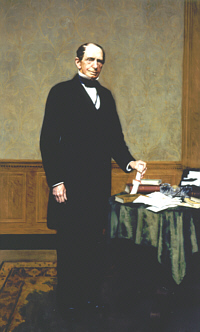
May 19: Johns Hopkins is born at Whitehall, his family’s tobacco plantation, in Anne Arundel County, Maryland.
1867
August 24: Johns Hopkins incorporates both his university and his hospital.
1868
Peabody Academy of Music opens under the direction of Lucien H. Southard with 148 students. In 1857 George Peabody had proposed the establishment of an institute in Baltimore to be comprised of a library, art gallery, academy of music, and a lecture series. Peabody had attended the dedication of the institute’s first building on October 25, 1866, and had declared, “I never experienced from the citizens of Baltimore anything but kindness, hospitality and confidence.” Building had been completed in 1861, but the Civil War had intervened.
1870
June 13: First meeting of the trustees for the university and hospital under the charters of 1867. Galloway Cheston, Baltimore financier and philanthropist and one of the original trustees of the Peabody Institute, is elected president of the university’s board of trustees.
1873
March 10: In his letter to the trustees of The Johns Hopkins Hospital setting forth the principles they are to follow, Hopkins states that the hospital must provide for “The indigent sick of this city and its environs, without regard to sex, age, or color, who may require surgical or medical treatment, and who can be received into the Hospital without peril to other inmates.” Letter also directs that the hospital should accommodate four hundred patients, and that a school of nursing and a school of medicine should be established in conjunction with the hospital.
December 24: Johns Hopkins dies at his residence at 81 Saratoga Street in Baltimore at the age of 78. The funeral, conducted according to the form of the Society of Friends of which Mr. Hopkins was a member, is held December 26 from his home; he is buried in Greenmount Cemetery. (Read The Baltimore Sun obituary.) The Baltimore Sun estimates his estate at $8 million, including $2.25 million in stock of the Baltimore & Ohio Railroad Company and $1 million in bank stock. In an editorial, the Suncompares Hopkins’ gift of the proposed university and hospital to those of George Peabody and Moses Sheppard and says of Hopkins, “It is gratifying to see a man who had thus successfully labored turning his attention ere life’s close to great schemes of beneficence, by which an undoubted good is to result which cannot be interred with his bones. The good which such men do lives after them, blossoming and bearing fruit for the improvement and happiness of future generations.”
1874
Peabody Academy of Music becomes the Peabody Conservatory of Music.
October: University trustees write to Daniel Coit Gilman, president of the University of California in Berkeley, requesting that he consider the presidency of Johns Hopkins. Gilman travels to Baltimore and meets with trustees on December 29 and tells them that he would create a major university devoted to research and scholarship. Trustees elect him president the following day.
1875
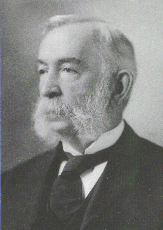
President Gilman begins his term as first president of The Johns Hopkins University. [Read Gilman’s inaugural address online.]
1876
February 12: At the annual meeting of the board of trustees of Peabody Institute, Judge George Brown makes the motion, which the trustees adopt, that “In view of the establishment of The Johns Hopkins University in our community, and of the wide field thus opened for the advancement of the intellectual & moral welfare of our people; and, desiring to establish, at the earliest date, affiliation with it in promoting the educational interests of the State: Resolved, That the Board of Trustees of The Peabody Institute convey to the President & Trustees of The Johns Hopkins University this expression of interest & good will; suggesting that this Institute being, within its scope, an educational element of the State, should be in sympathy with the university, and by interchanges of courtesy, and cooperation, assist in its high educational aims.”
February 22: Daniel Coit Gilman is inaugurated as first president of The Johns Hopkins University during ceremonies at the Peabody Institute where the Peabody Orchestra performs. An editorial in the Gazette proclaims, “We consider this one of the most important events in the recent history of the city. Baltimore, which has so often been reproached as a big provincial town, is about to become the seat of a great university — a city set on a hill, a center of light.”
September 12: Thomas Huxley delivers the university’s opening address and sparks controversy among those who see his writing as subversive of religious faith.
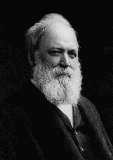
October 4: First lecture at the new university given this day at 5 p.m. by Professor Basil Gildersleeve on Greek lyric poetry. Classes for students begin the next day. The faculty is composed of Gildersleeve (classics), James J. Sylvester (mathematics), Ira Remsen (chemistry), Henry A. Rowland (physics), and Henry Newell Martin (biology). [Learn more about Basil Gildersleeve online.]
1878

Professor James J. Sylvester edits the first issue of the American Journal of Mathematics, and it is published “under the auspices of” the Publication Agency of The Johns Hopkins University. The New York Times says, “Johns Hopkins University ought to become the highest court of appeal in theoretical science and philosophy. Looking to occupy a position of this kind, it is very appropriate that so important a step as the foundation of a journal of pure and applied mathematics should be taken by the Baltimore university.” [Learn more about James Sylvester online.]
Summer. Dr. William K. Brooks of the biology department opens a laboratory on the Chesapeake Bay, the first undertaking of its kind by a university and the first such laboratory south of New England. By 1880 The Johns Hopkins University Marine Zoological Laboratory has moved to Beaufort, North Carolina.
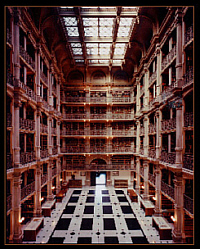
September 30: Peabody Library occupies a new building designed by Edmund G. Lind, who also designed the original building. The central well is sixty-one feet high, with six levels of stacks supported by cast-iron pillars. Fifteen percent of the library’s holdings are not duplicated in the Library of Congress.
1879
Professor Ira Remsen edits the first issue of the American Chemical Journal, which is published by the publication agency. [Learn more about Ira Remsen online.]
June: George W. McCreary, A. Chase Palmer, and Edward H. Spieker receive bachelor of arts degrees as the first graduates of The Johns Hopkins University.
1880
Basil L. Gildersleeve edits the first issue of the American Journal of Philology, which is published by the publication agency.
1881
April 22: Alexander Graham Bell lectures to a large audience in Hopkins Hall on his experiments with the transmission of sound by using rays of light instead of wires.
1882
June 3: First Peabody graduates receive their diplomas.
December: Herbert B. Adams, associate professor in history, edits Studies in Historical and Political Science, the first monograph series published by The Johns Hopkins University Publication Agency.
1883
January 30: In an address before the YMCA of Baltimore, John Work Garrett criticizes his fellow trustees for spending “enormous sums in the City of Baltimore and not at Clifton Park,” Johns Hopkins’ country estate where both men had expected the university to locate. Clifton is gradually whittled away by condemnation: in 1879 for a reservoir, in 1892 for a railroad right-of-way, and finally the remainder of the estate in 1895 for a public park. A close friend, neighbor, and colleague of Johns Hopkins, Mr. Garrett also takes issue on several occasions with the emphasis on graduate study and research which, he implies, prevents the university from doing much for the young men of the region, whom Mr. Hopkins had wanted to aid.
May 1: Druids Club of Baltimore defeats the newly formed Johns Hopkins lacrosse club 4-0. This is the last official game until 1888, when Hopkins enjoys its first win, a 6-2 victory over the Patterson Club. From 1888 Hopkins teams play every season except 1944, when athletics are curtailed by World War II.
December 3: The American notes, “Whenever there is a lecture at Johns Hopkins University upon a plain, everyday topic of practical importance, the audience consists almost exclusively of men; but when a speaker gets up to talk about abstruse psychological subjects, such as are discussed by Mr. Stanley Hall, there is always a large number of ladies present. The same singularity is noticed at the Peabody lectures when profound themes are elucidated.”
1884
The Johns Hopkins Glee Club gives its first concert. Woodrow Wilson sings first tenor. Wilson receives his Ph.D. in 1886; in 1913 he becomes the only U.S. president to hold an earned doctorate.
1885
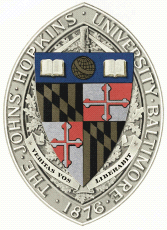
May 4: University trustees adopt the official seal presented by Stephen Tucker of London. Tucker describes the seal as presenting “an heraldic picture of a University situated in the State founded by Lord Baltimore.” The seal carries the motto “Veritas vos Liberabit” (John 8:32) and the legend “The Johns Hopkins University: Baltimore: 1876.”
1886
Proficiency in Applied Electricity course to train students for engineering positions opens under the leadership of Louis Duncan. The course had been requested by local industry, especially the Baltimore & Ohio Railroad. The program is offered within the department of physics led by Henry A. Rowland, under whom Duncan had obtained his Ph.D. Duncan tells President Gilman that he sees the course as teaching “electricity as a science and in its practical application.” Course runs for thirteen years and certifies ninety-one students, almost all of whom become practicing electrical engineers.
April 26: A resolution is offered for formation of an alumni association at the observance of the tenth anniversary of the university at Mount Vernon Place Methodist Church.
1887
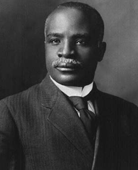
Kelly Miller, the first African-American student to enroll at Johns Hopkins University, begins his studies for a graduate degree in mathematics with the encouragement of Simon Newcomb, professor of mathematics. Miller is obliged to leave two years later when the university’s economic crisis prompts a twenty- five percent increase in tuition. Some years later, Newcomb and President Gilman recommend Miller for a faculty position at Howard University, his undergraduate alma mater, where he serves for many years as professor of mathematics and dean of arts and sciences.
1888

April 10: Hospital board learns that the hospital is completely finished inside and out except for the gas fixtures.
November 13: Daniel Coit Gilman and the Reverend J. F. Goucher give addresses at the opening ceremonies for the Woman’s College of Baltimore. The Sun deems it “one of the most comprehensive of its kind in the world, and a fit companion for the Johns Hopkins University.”
1889
May 7: About six hundred people attend ceremonies formally opening The Johns Hopkins Hospital. Mrs. Daniel Coit Gilman, writing to her daughters, describes the occasion: “Of course the great event of the week has been the opening of the hospital. The day was superb and all the buildings in apple pie order; grounds ditto. The exercises were in the administration building and a band of twenty- five instruments was in the third gallery. There was plenty of bunting and flowering plants and ladies in their gay dresses and it was a very pretty scene. Mr. Francis King made an excellent little address and Dr. Billings a very sensible one and Papa touched the popular heart as usual. I think all the speeches struck a very high note. There was no self-glorification, no mere spread eagle and empty oratory but a tone of earnest responsibility in the presence of a great trust. I think everyone must have been struck with it.”
September: Failure of Baltimore & Ohio Railroad stock creates a crisis in the university’s finances. Professors accept reduced salaries and fees are increased. President Gilman says 1889-90 school year will begin as usual.
October 9: The Johns Hopkins Hospital’s School of Nursing formally opens. Miss Isabel Hampton, first superintendent of nurses, speaks on the role, training, restrictions, and duties of nursing. The next day, an editorial in the American says the training school for nurses “is destined to be in the coming years scarcely less important and useful than the development of the more imposing science of medicine and surgery, of which it is rapidly growing to be the twin companion. Without careful nursing, medicine and surgery are crippled agencies in the preservation of health and life, and with careful nursing it is often possible to preserve both without their assistance.”
1890
March: Eight thousand books bequeathed to Johns Hopkins University by John W. McCoy are being readied for use. Collection concentrates on illustrated folios of geography and topography and engraved reproductions of the fine arts. Mr. McCoy, a Baltimore businessman, left his pictures and statues to the Peabody Institute.
April 13: The New York World runs an article with the headlines: “Sober Johns Hopkins. It is a university of manly young men. Dudes are seldom found there.” The text continues, “Johns Hopkins University is a steady-going place, containing few dudes and no students who lead the sumptuous lives that characterize the Harvard men. The classes are made up largely of manly fellows who mean business and who have little time to devote to college frivolity.”
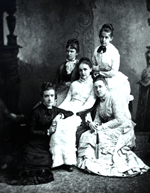
May 2: Five Baltimore women organize the Women’s Fund Committee. M. Carey Thomas, Mary Elizabeth Garrett, Mary Gwinn, Elizabeth King, and Julia Rogers intend to raise money needed to establish the School of Medicine with the condition that the school will accept women with the same high qualifications as male applicants. Women in Boston, Philadelphia, Washington, New York, Chicago, San Francisco, and other cities join with Baltimore women.
November 25: Professor William K. Brooks warns that unless oysters are planted, they will die out.
1891
The Johns Hopkins University lacrosse team wins its first national title in the Intercollegiate League, followed by championships in 1898, 1899, and 1900; Hopkins then withdraws from the league to become a charter member of the Intercollegiate Lacrosse Association.
The Publication Agency of The Johns Hopkins University becomes The Johns Hopkins University Press and remains under the direction of Nicholas Murray who is also librarian of the university.
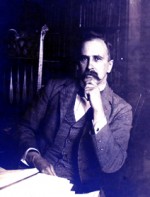
June 5: Dr. William Osler, physician-in-chief of the hospital, addresses the first class to graduate from The Johns Hopkins Hospital’s School of Nursing and tells the new alumnae, “Practically, there should be for each of you a busy, useful, and happy life; more you cannot expect; a greater blessing the world cannot bestow. Busy you will certainly be, as the demand is great, both in private and public, for women with your training. Useful your lives must be, as you will care for those who cannot care for themselves, and who need about them, in the day of tribulation, gentle hands and tender hearts. And happy lives shall be yours, because busy and useful; having been initiated into the great secret — that happiness lies in the absorption in some vocation which satisfies the soul; that we are here to add what we can to, not to get what we can from, life.”
May 15: Peter Ilich Tchaikovsky performs at the Peabody Conservatory of Music. October 1: Classes begin for the university’s sixteenth year. Two days later, the BaltimoreAmerican reports that Miss Florence Bascom, daughter of the ex-president of University of Wisconsin, will “take part” in the geological department, “giving special attention to the course in geography conducted by Professor Williams.” Bascom’s admission will not be as a “member proper” of the university; she will not pay tuition; she will not appear on the roster of students. Johns Hopkins sometimes allows this if no like instruction is offered at women’s schools. Thus, Bascom’s admission “marks no change in the general attitude of the university towards the admission of women to its courses.”
December 16: McCoy Hall, a new academic building, is being planned by architects. To make room for the new structure, Levering Hall will have to be moved by jackscrews westward to Eutaw Street. The following July the trustees agree to the design and award a contract. Move of Levering Hall begins the week of the August 12.
1892
March 15: Dr. Henry Hurd recommends that a separate ward for colored patients be built and the hospital trustees vote that his motion be referred to the executive and building committees. The American reports that the building will be erected to the east of the isolation ward on the east end of the hospital. It will have a center wing of three stories and north and south ward wings of two stories, with accommodations for fifty-six patients, men on first floor, women on second. Nurses will occupy the third floor of center wing. “Special care will be taken to see that the heating and ventilation apparatus is as perfect as possible. A sun balcony will be erected on each floor on the east side, for convalescents, while a sun bay-window will be constructed at the south end of the south wing. On each floor there will be a dining room, kitchen, lavatory and bath-rooms. . . .The building will be fireproof throughout.”
November 1: National Academy of Sciences meets this week at physical laboratory of Johns Hopkins University. Hopkins professors Rowland, Remsen, Brooks, and Williams present half of the papers at the meeting. Public attendance in Baltimore is unprecedented.
December 22: Mary Elizabeth Garrett announces that she will give more than three hundred thousand dollars so that the Women’s Fund Committee can meet its goal to open the medical school. Garrett stipulates that not more than fifty thousand dollars may be spent on buildings, and the main building shall be known as the Women’s Fund Memorial Building and that the school must be a four-year graduate school for men and women who are to be admitted without distinction between them. She also requires the creation of a committee of six women “to whom the women studying in the medical school may apply for advice concerning lodging and other practical matters, and that all questions concerning the personal character of women applying for admission to the school and all non-academic questions of discipline affecting the women studying in the medical school shall be referred to this committee, and by them be in writing reported for action to the authorities of the university.” University trustees accept Garrett’s gift and her conditions on December 24. An editorial statement in the Sun says, “The women of the country are to be congratulated upon finding so generous a champion as Miss Garrett has proved to be, and the university has no less cause to be congratulated. All will wish for the success of this important step toward the education of women in a profession where equal opportunities with men have been so long denied them.” [Learn more about Mary Elizabeth Garrett, founding benefactor of the School of Medicine, online.]
1893
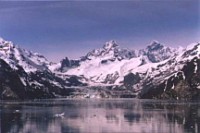
1893: Harry Fielding Reid names a glacier in Alaska after his alma mater, The Johns Hopkins University, where he earned both a bachelor’s degree and a Ph.D. in physics. Johns Hopkins Glacier is located in Glacier Bay National Park.
June 13: Florence Bascom becomes Johns Hopkins University’s first female Ph.D. TheAmerican notes that Miss Bascom is “very modest” and did not attend ceremonies to receive her diploma.
October 2: Dr. William Welch, professor of pathology in the university and the hospital’s pathologist, reviews the credentials of sixteen applicants to the School of Medicine, five of whom are graduates of Johns Hopkins University. All of the applicants, including three women, are admitted and classes begin.
1894
Sisters Marian and May Garrettson Evans open the first music school for Baltimore children, the forerunner of the Peabody Preparatory School.
October 8: About a thousand people inspect the new McCoy Hall, which is lighted by electricity. The building also features two large electric elevators, said to be the first in Baltimore. Classrooms, offices, and lecture rooms are on the second and third floors, and a library with thirty thousand volumes is on the fourth.
1895
October 11: President Gilman meets with students to talk football and rouse interest in the sport. The Sun reports that Baltimore businessman Edgar Allan Poe, former coach of the Princeton team and of at least one disastrous Johns Hopkins team, chides, “You must keep abreast of the other colleges. Football is today recognized as the typical college sport, the national college game. And you ought to be ashamed to have it said that such a great university as this is has no team to represent it.” Poe contends that “nothing develops a man’s character more, quickens and makes more perfect his self- reliance, makes him think quickly and act promptly, develops his muscles, his brain, his courage, his courtesy. It is the safest and most legitimate outlet for animal spirits among young men.”
December 19: Professors and graduate students who have been members of chapters in other colleges organize the Johns Hopkins University chapter of Phi Beta Kappa Society. The Hopkins chapter is to be called Alpha of Maryland. Daniel Coit Gilman is elected chapter president and eighty-six men who have received bachelor’s degrees from Johns Hopkins (of more than four hundred total) are selected for alumni membership.
1896
May 20: William Bullock Clark, professor of organic geology who is also the state geologist, sails with six scientists for the Eastern Shore on an oyster navy boat. They will do preliminary work on state geological survey.
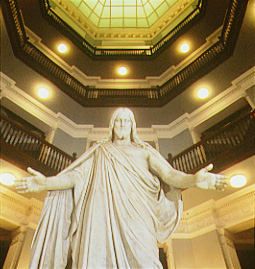
October 14: Statue of Christus Consolator, the gift of William Wallace Spence of Baltimore, is unveiled in the rotunda of hospital by Emily Riggs, four- year-old great-granddaughter of the donor. The figure is a copy of a statue created by Danish sculptor Bertel Thorswaldsen.
1897
June 15: First class graduates from Johns Hopkins University School of Medicine. The fifteen graduates include Mary Packard of Bayonne, New Jersey, one of the three women who had entered with the class.
James M. Thompson and Edgeworth Smith found the News-Letter to give undergraduates news on campus. Trustees had initially opposed the idea of a campus paper, but eventually allow four issues to be published at the end of the 1896-97 school year. Trustees give formal approval the following year. Paper is printed every two weeks of the school year for the first twelve years, and is largely literary in character with articles written by both faculty and students. In 1909News-Letter becomes a six-page weekly newspaper. (Visit the News-Letter online.)
1898
November 4: A course of lectures in history especially for teachers in the Baltimore public and private schools begins at 8 p.m. The next morning a scientific course for teachers begins in the geological lecture room of Hopkins Hall. Each course will have twenty lectures.
1899
March 22: Members of an expedition from the medical school meet in Chicago to begin a journey around the world. They will go to Hong Kong, and Japan, and set up headquarters in Manila to study tropical diseases.
June 2: More than one hundred alumni, faculty, and graduate students join the new Johns Hopkins Club. (Visit the Johns Hopkins Club online. )
1901
February 5: Local newspapers announce the proposed gift of 151.75 acres of land on Charles Street as a new site for The Johns Hopkins University. Donors William Wyman and William Keyser stipulate that $1 million in endowment must be raised.
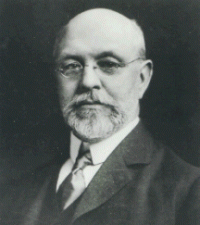
June 11: Daniel Coit Gilman gives his farewell address as president of Johns Hopkins. Gilman congratulates the university on the selection of Ira Remsen as its next president.
1902
February 22 and 23: Johns Hopkins University belatedly celebrates its twenty-fifth anniversary and inaugurates its second president. Woodrow Wilson of Princeton University presents Daniel Coit Gilman with a testimonial gift from the alumni that contains the signatures of more than a thousand graduates. The Peabody Orchestra plays the processional.
November 6: Frederick Law Olmstead Jr. views grounds of the future Homewood campus with President Ira Remsen.
1903
Henry Phipps, an iron and steel magnate, donates ten thousand dollars for the establishment of a tuberculosis clinic at The Johns Hopkins Hospital.
Dr. and Mrs. Christian Archibald Herter of New York give twenty-five thousand dollars to found a memorial lectureship in the medical department “designed to promote a more intimate knowledge of the researches of foreign investigators in the realm of medical science.” First lecture at the opening of the 1903-1904 academic year is given by Dr. Herter himself on the “Influence of Pasteur on Medical Science.” Forty years later, Dr. Herter’s nephew became one of the founders of the School of Advanced International Studies.
1904
February 7: Hospital loses seventy properties, most of them warehouses, in the great Baltimore fire. The buildings had yielded one-half of hospital’s annual endowment income that helped fund its free dispensary. This work is now threatened. The university does not hold its regular Commemoration Day exercises on February 22 because of the fire’s enormous impact on the city. In May the hospital receives a letter from John D. Rockefeller Jr. “In view of the high character of work which the hospital and medical school are doing in medical instruction and research, including the training of nurses, which work he understands will otherwise be materially curtailed because of the losses, my father will give five hundred thousand dollars to Johns Hopkins Hospital.”
February 17: Poet William Butler Yeats visits Johns Hopkins University and lectures the English seminary on drama.
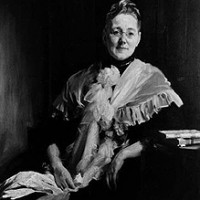
October 4: A portrait of Mary Elizabeth Garrett painted by John Singer Sargent of London is unveiled in the rotunda of the hospital and will remain there for several days for inspection by the public before being given a prominent place in the institution.
October 5: Dr. William S. Halsted performs the first operation in the new surgical amphitheater. A team of residents handpicked by Halsted to assist him includes Joseph Bloodgood, Richard H. Follis, James Mitchell, Harvey W. Cushing, Hugh H. Young, and J. M. T. Finney.
1905
February 22: Dr. William Osler delivers a farewell address at Commemoration Day celebration before leaving for England to become regius professor of medicine at Oxford University.
May 17: The Baltimore News describes “New Wyman’s Park” in “North Baltimore,” which has not yet formally opened. The park is nearly a mile long, but narrow, located along east bank of Stony Run from Merryman’s Lane to 29th Street, with frontage on Charles Street for one block. The park circles around to rear of proposed site of The Johns Hopkins University. “It is a very rough and heavily wooded territory” famous for chestnut expeditions. The park board is building drive that will emphasize the land’s natural beauty.
June: Pathologist William H. Welch, surgeon William S. Halsted, and gynecologist Howard A. Kelly of the original medical faculty at Johns Hopkins University meet their former colleague William Osler in London and sit for a portrait by John Singer Sargent. Mary Elizabeth Garrett will bear the expense of the painting.
June 5: Florence Sabin is promoted to associate professor of anatomy. The following week the Baltimore News comments that “The appointment of a woman to a position of this rank in an institution of such distinction as the Johns Hopkins Medical School, and other than a college for women, is without parallel among American universities, in the Eastern section of the country at least.” Dr. Sabin received her medical degree from Johns Hopkins University in 1900; in 1917 Sabin becomes the first woman at Johns Hopkins to be appointed to a full professorship.
1906
April: Professor Henry A. Rowland’s multiplex telegraph is used by the Italian government to transmit messages from Naples during eruptions of Mount Vesuvius. For a time, these are the only telegraphic messages to get through. [Learn more aboutHenry Rowland online.]
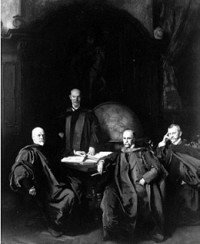
May: John Singer Sargent’s The Four Doctors is the centerpiece at a private showing before the opening of the 138th exhibition of the Royal Academy. The New York Sun reports that the painting is considered to be “the noblest work of art that has been hung in the Royal Academy since Sir Joshua Reynolds was president of it, and the most important and impressive of its type that has been painted by any man since the seventeenth century drew its curtain across the art of Holland.”
May: University trustees approve a four-year undergraduate plan, although a bachelor’s degree can still be secured in three years. Sub-freshman class will become freshmen and regular freshmen to become sophomores. Twenty courses are required for graduation.
1907
January 19: The Four Doctors is unveiled in McCoy Hall.
April 9: Registrar Thomas Ball announces that women “who have taken a baccalaureate degree at any institution of good standing” may be eligible to be admitted to graduate school at Johns Hopkins University. President Remsen observes “It was simply a matter of justice — I should say of justice and common sense.” The News notes that, previously, there have been “other special students from time to time.”
May 28: New athletic field is finished at Homewood and stands for spectators are being constructed. All should be ready by October for football games. Medical students are not expected to compete any longer since Homewood Field is so far from the hospital.
1908
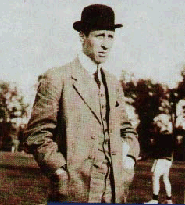
Johns Hopkins University lacrosse club plays its first game on Homewood Field under coachWilliam C. “Father Bill” Schmeisser, and shares the national championship with Harvard.
May: University trustees approve a master of arts degree that will be granted when a Ph.D. is impossible or unnecessary. The M.A. degree is especially suited to public school teachers.

June: A generous gift from philanthropist Henry Phipps permits the hospital to establish America’s first clinic for the treatment of mental illness and endows a professorship of psychiatry at the university. September 17: Fire damages McCoy Hall. Sargent’s portrait of The Four Doctors is protected when newspapers are rolled up and placed behind it to keep it away from the wall.
October 9: Botany professor Duncan S. Johnson announces that regular work of his department will move to the Homewood campus since the new botanical gardens and greenhouse are ready.
October 13: Daniel Coit Gilman dies at the home of his sister in Norwich, Connecticut.
1909
June: President Remsen announces that the university will offer college courses for male and female teachers at public and private schools in cooperation with the Woman’s College of Baltimore. Classes will start in October and continue to June. They will allow teachers to continue their professional duties and still attend classes.
November 20: Johns Hopkins University beats St. John’s College 18 to 0 in the first football game between the traditional rivals at Homewood Field.
1910
April: Campaign to raise $2 million to to build necessary buildings and move the university to Homewood is announced.
The Carnegie Foundation issues a report on education by Abraham Flexner that singles out Johns Hopkins as a leader in medical education. Five years later, Flexner notes that Hopkins, “fortunate in its freedom from all entanglements, in its possession of an excellent endowed hospital, and, above all, in wise and devoted leadership, set a new and stimulating example precisely when a demonstration of the right type was most urgently needed.”
1911
February 22: University board of trustees president R. Brent Keyser announces that construction will begin next summer on Homewood campus with the building of a hall dedicated to the memory of Daniel Coit Gilman.
May 8: Newspapers announce that faculty at the medical school will no longer be allowed to have private medical and surgical practices and must devote all their time to research and teaching. The change will severely restrict the income of popular physicians and the university is proposing to pay larger salaries.
June 13: So many degrees are awarded that recipients no longer fit onto the stage of the Academy of Music. Four women have earned Ph.D.s, six M.D.s, and three M.A.s. The next day, the Evening Sun remarks that “Many people are waking up to the fact that the Johns Hopkins is a coeducational institution, and announcing their discovery to their friends in accents of amazement.”
July: Peabody Conservatory initiates a summer program in cooperation with Johns Hopkins University. The university also offers summer school for teachers of both sexes. Students have access to all the resources of the university. Classes include social hygiene, physics, education, English, German, manual training, chemistry, domestic science, biology, mathematics, Latin, French, and history.
1912
April 4: Governor of Maryland signs a law to fund “a school or department of applied science and advanced technology” at The Johns Hopkins University, establish scholarships, and give Hopkins enough money to build at Homewood. The law authorizes a bond issue of six hundred thousand dollars to construct buildings and provide equipment, and to furnish fifty thousand dollars per year for maintenance. Hopkins is to give 129 scholarships of free tuition to “worthy men of this State” to the school of advanced technology or “courses preparatory thereto.” The following month, the trustees agree to the state’s conditions. In 1913 the school enrolls its first students, including Abel Wolman, (although a number of students are admitted the previous fall to take mathematics and physics courses preliminary to their engineering studies). First undergraduate engineering degrees are awarded in 1915. The department becomes the School of Engineering, with John Boswell Whitehead as its dean, in 1919.
Second summer school at Johns Hopkins again includes a session in conjunction with the Peabody. Musical performances at Peabody are interspersed with lectures at the university.
September: Announcement is made that a new building named for Charles L. Marburg (whose heirs had given one hundred thousand dollars in 1907) will be constructed for the use of private patients.
October 14: The Sun reports that Dean J. Whitridge Williams says that number of medical students will be limited so that facilities will not become overcrowded. This year there are 355 medical students; almost fifty applicants have been turned away. Williams says that a limit on the number of students is “essential to the preservation of high ideals and of proper methods of teaching and that further expansion cannot be expected until those interested in the advancement of medical education add materially to its endowment and to that of Johns Hopkins Hospital.”
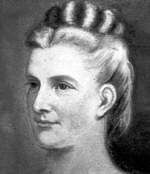
November 20: Harriet Lane Home for Invalid Children opens.
December: First issue of Johns Hopkins Alumni Magazine, a quarterly designed to keep alumni “in closer touch with their alma mater” is published. (Visit the Johns Hopkins Magazine online.)
1913
January 14: The Sun writes that Robert W. Wood, head of the physics department, has developed “invisible-ray photography” and has used ultra-violet rays to take pictures of the moon. Professor Wood intends to make series of ultra-violet and infra-red photos of planets.
February 10: The American announces that Johns Hopkins is the third U.S. hospital to be equipped with an x-ray machine. A few nights ago, physicians Howard A. Kelly, C. F. Burnam, Frederick Baetjer, and Leonard Roundtree worked all night in a lab to set up the machinery. In order to work without tiring, “It was agreed that the radio-rays be turned on for light, and in this manner a new virtue of the radium was discovered — that where the rays shone there was no sleep to be had, for the light is visible even when the eyes of those about it are closed.” By the time Dr. Baetjer dies of heart disease in 1933 at the age of 58, he has lost all his fingers and undergone more than one hundred operations as a result of his x-ray experiments.
1914
Peabody Conservatory initiates the first formal music education program in Maryland, a model for later programs at other colleges in the state. Graduates are awarded a school music curriculum certificate.
September 28: A wagonload of books (formerly part of the engineering library in the physics lab on Monument Street) arrives at the new Mechanical and Electrical Engineering Building at Homewood. The engineering department faculty will move in the following days. Students will be able to watch turbines and other large equipment being installed in the coming months.
October 5-8: The twenty-fifth anniversary of the hospital is observed.
October 9: James Buchanan “Diamond Jim” Brady makes a surprise visit to East Baltimore to inspect the new urological building for which he has provided funds. He is so pleased with the nearly completed building that he has draws up a new will to provide money for its maintenance and improvements. The American reports that, “as usual, Mr. Brady wore a princely array of diamonds.”
October 15: Librarian M. Llewellyn Raney announces that new library in Gilman Hall will be arranged in a unique way. Some universities have all books in one large room under control of one librarian; others separate books by subject in accessible reading rooms. In the past, Johns Hopkins University has used the latter system. Raney proposes to gain the advantages of both systems by designing the library in two stacks from basement to top floor, each resting on its own foundation. Each stack will have nine decks, two on each floor, except the top floor which has only one deck. Books belonging to various departments will be placed on the same level as the classrooms and offices of that department.
1915
May 21: Henry Carter Adams, the first person to receive a Ph.D. from The Johns Hopkins University (because his last name was at top of alphabet in 1878) dedicates Gilman Hall and General George W. Goethals, the army engineer who had managed the Panama Canal’s construction, dedicates the new engineering building before an immense crowd. President Woodrow Wilson was expected, but could not leave Washington.
1916
February 11: Peabody faculty members and Peabody-trained musicians form the core of the Baltimore Symphony Orchestra as it plays its first concert. Baltimore’s is the only municipal symphony orchestra in the United States.
June 13: Dr. William Welch announces that The Johns Hopkins University has received a grant from the Rockefeller Foundation to establish a school of hygiene. Welch will be its director and Dr. William H. Howell will head the physiological department.
October 16: The first Reserve Officer Training Corps in the United States is established on the Homewood campus.
1917 March: Members of the junior engineering class at Johns Hopkins University build two flag staffs in front of Gilman Hall as memorials to Bob Layfield, a Hopkins quarterback who died in the spring of 1915 as a result of injuries received in a football game in 1914.
Thirty-two medical students are among those who serve at the Johns Hopkins Base Hospital 18 in Bazoilles-sur-Meuse, France. They spend their senior year attending lectures and rounds with their professors and tending to the wounded in a thousand-bed facility built early in the war by the French government. By late 1917, the base hospital is filled with American victims of gassing as well as battle and bomb casualties. As the war progresses, the base becomes an evacuation hospital with the operating room in use around the clock. Tents are erected to handle the overflow of patients. Two medical students and two Hopkins nurses die from diseases contracted in the hospital. The remaining thirty students receive their medical degrees in April 1918 while still in France.
October 5: The Sun comments in an editorial that “The Johns Hopkins University is meeting a very present need in continuing the night courses in technology which were begun last year. The public response to this opportunity and privilege ought to be even greater at this time than it was twelve months ago. Higher education is suffering from the shock and disarrangement of war.”
1918
October: The School of Hygiene and Public Health opens in the physical laboratory of the old downtown campus with Lieutenant Colonel William H. Welch as its director. Welch is on active duty as a member of the surgeon general’s staff in Washington. At present the student body consists of persons ineligible for military service, among whom are two South American physicians, three women, one public health instructor and one medical student.
October 7: All classes at Homewood are suspended because of an influenza epidemic. Courses affected include the Students’ Army Training Corps, college courses for teachers, and night courses in business economics and those for technical workers. SATC classes resume in a few days.
1919
May 23: Charles H. Bochau of the Peabody Conservatory faculty conducts the first concert by the Johns Hopkins orchestra. Sixty musicians are joined by members of the glee club.
June 18: Alumni who gather in Baltimore for a reunion decide to fund a residence hall for the Homewood campus to be named in honor of all the Hopkins men who gave their lives or participated in the late war.
November 28: A fire at the downtown campus virtually destroys McCoy and Levering Halls and many adjacent houses. This is declared the worst fire in the city since 1904. A few weeks later, on January 3, fire strikes the hospital’s pathology building on the southwest corner of Wolfe and Monument Streets. The Sun reports “When the flames leaped into the air and the word spread over the city that the hospital was afire hundreds of relatives and friends of patients hurried to the scene in taxicabs, automobiles, and trolley cars.”
1921
February 22: Franklin D. Roosevelt, former assistant secretary of the navy, speaks at the annual Alumni Association dinner that follows Commemoration Day events at the Lyric.
December 23: An anonymous donor endows the Department of Art as Applied to Medicine at the School of Medicine. Max Brödel has headed the department since its inception.
1922
After several years of studying nutrition-related issues, Elmer V. McCollum and a team of researchers at the School of Hygiene and Public Health discover vitamin D. [Learn more about E.V. McCollum online.]
February: Rockefeller Foundation gives $1 million to erect new buildings for the School of Hygiene and Public Health, and $5 million toward its endowment.
May 5: Professors Arthur O. Lovejoy, Gilbert Chinard, George Boas, and others interested in the exploration of ideas by scholars in various fields convene the first formal meeting of the History of Ideas Club.
June 12: Alumni break ground for the new residence hall at Homewood. Students occupy Alumni Memorial Residence in September 1923.
September: Registrar Thomas R. Ball indicates that the university will not bar student use of automobiles. “Some of the students waste a good deal of time riding about in automobiles, but this holds good for the public in general. Automobiling for pleasure is indulged in to an unnecessarily great extent.”
1923
January 7: Tudor and Stuart Club forms thanks to a generous gift from Sir William and Lady Osler. The Oslers want the club to serve as a memorial to their son Edward Revere Osler who was killed in the war in 1918. The Sun notes that the Oslers see the benefaction as a “grateful recognition of the happy years” they had spent in Baltimore. They hope the club will promote study of English literature of the Tudor and Stuart periods and promote “good fellowship and a love of literature among the members.”
February 9: Undergraduates vote 232 to 37 against what the News-Letter calls “female intrusion into the undergraduate body.” Coeducation issue had arisen the previous fall when some women students in the College for Teachers had asked for equal status and the same degrees as men in undergraduate school.
April 23: Interclass rivalry results in arrest of one student after a near riot at downtown hotel; four sophomores are arrested for suspicious behavior while attempting to kidnap a freshman.
October 13: Professor Knight Dunlap of the psychology department publishes preliminary results of three years of experiments on the effects of smoking. Study indicates that accuracy of work is negatively affected by smoking, but not speed. Smoking may have a negative affect on thought processes, but accuracy may also be decreased by deprivation of smoking.
November 9: Students ignite the annual bonfire in preparation for the football game with St. John’s. The Sun reports “A tackling dummy in the uniform of St. John’s was cremated noisily in the rear of the engineering buildings on campus.” Revelers then march down Charles Street and serenade Goucher girls.
November: Ichiro Ohga, a graduate student from Japan, sprouts ancient lotus seeds in the plant physiology lab behind Gilman Hall. The Sun notes that the seeds had been found “under layers of peat, some of them 15 feet deep, in the bottom of what once was a pond on the edge of the Gobi Desert.” It is speculated that the seeds may be five hundred years old.
December 4: The Baltimore News announces that a railway test set, designed by Professor William B. Kouwenhoven and built by Westinghouse Electric and Manufacturing Company, will soon be in operation in Machinery Hall. The model will be used for lab tests by students in electrical engineering and for research. “The outfit consists of two 25-horse power railway motors, the same as those used in one-man trolley cars” The newspaper comments that “such test sets are comparatively rare in this country. In most of the technical schools where they have been installed the high voltage required to operate the sets has rendered them unsafe for experiment.”
1924
January 9: The Women’s Clinic is dedicated at the hospital, made possible by a generous gift from Mrs. Lucy Wortham James of New York. Gynecologist Thomas S. Cullen and obstetrician J. Whitridge Williams (former dean of the School of Medicine) direct the new clinic.
Florence E. Bamberger becomes the first woman appointed a full professor (in education) in the Faculty of Philosophy.
August: The chemistry department finally makes the move to the Homewood campus. The Sun reports, “Highly flammable metals, acids and other substances, including gas explosive material” have been moved from old chemical laboratories on the downtown campus to the new chemistry building. A special police escort guards the truck. The newspaper notes that in recent years the old building had vibrated so badly from streetcars and trains that experiments had to be made in the middle of the night to keep vibrations from interfering with chemical action. Ira Remsen, the university’s first professor of chemistry and its second president, will have an office in the new building. After Remsen’s death in 1927, the building is named in his honor and his ashes are interred in a wall there.
1925
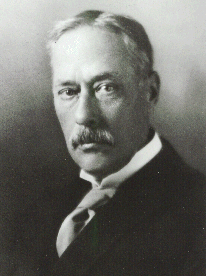
February 21: President Frank Goodnow announces his proposal to eliminate the first two years of the undergraduate program, award no bachelor degrees, and raise the whole university to the level of a graduate school.
August 12: The School Hygiene and Public Health begins move to its new building at East Monument and Wolfe Streets.
October: The Sun reports that until a new structure can be built for it at Mount Vernon Square, the Peabody Preparatory School is moving into the old physical laboratory at 301 West Monument Street, “which is all that remains of the group of buildings where The Johns Hopkins University first came into being.” The Prep moves to Leakin Hall in 1926.
1926
The Tudor and Stuart Club hosts poet Robert Frost, who reads to a crowded assembly.
The State of Maryland authorizes the Peabody Conservatory to grant bachelor of music degrees.
The Sun interviews William “Billy” Stewart, who has been custodian of the chemistry department since its opening in 1876, on the occasion of his seventy-first birthday. Stewart reminisces, “I liked those days when the classes were small and everybody knew each other by name. Now there are too many students to get acquainted with all of them. Lots of them speak to me and I know only their faces. I don’t care at all for those flapping trousers and falling down socks worn by some of the fellows. In the early days most of the men dressed plainly and naturally. Some of them wore wing collars and gaiters to classes, but they were never undignified. There was none of this modern foolishness and swagger in dress. Once they tried the cap and gown for seniors, but that didn’t last long. There wasn’t much hazing of the new students in those days, as there is now. The fellows didn’t seem to have time for that sort of thing. Bicycles were popular then. I still can remember Dr. Ira Remsen, head of the chemistry department, riding down the avenue on his bike. In the early days there wasn’t any prohibition law to prevent a man from taking drink in peace if he wanted to. I can recall the old Saturday night club, where graduate students and professors used to meet every week to discuss learned subjects over their beer.”
February 22: At fiftieth anniversary Commemoration Day exercises, the university awards a Ph.D. to seventy-nine-year-old Christine Ladd-Franklin, who had earned the doctorate in 1882. Ladd had been the first woman to teach in the Faculty of Philosophy when, from 1904 to 1909, she lectured in logic and psychology. The belated granting of the degree to the brilliant scholar provokes Sun columnist Anne Kinsolving to ask, “Is Johns Hopkins University now conferring an honor upon Mrs. Christine Ladd-Franklin, or is Mrs. Christine Ladd-Franklin conferring an honor on Johns Hopkins University?”
April 26: Department of Art as Applied to Medicine mounts an exhibit at the Baltimore Museum of Art at 101 West Monument Street.
September 30: In his annual report, President Goodnow acknowledges that the university cannot adopt his new plan without more endowment to replace the income that will be lost with no freshmen and sophomores. “We can and should, however, always keep in mind the ultimate goal which we are striving to reach.”
October 21: An eight-story residence for nursing students opens at the corner of Broadway and Monument Street. The building is named Hampton House to honor Isabel Hampton, the first superintendent of nurses.
1927
March 19: Plans for the construction of a library for medical and public health students and the hospital are announced. When the library is built, it houses the Department of the History of Medicine (later called the Institute of the History of Medicine) and William H. Welch becomes the department’s first director. The Alumni Magazine notes “There is a room for a secretary, but there is no secretary. Dr. Welch’s associates are wondering what he is going to do about that. He has not, throughout his life, engaged a secretary. He prefers to conduct all correspondence himself.”
March 22: Sophomores storm the National Guard Armory in Annapolis where the freshman class are holding their banquet. Police and fire departments arrive and ten students are jailed on charges of destroying state property, malicious mischief, and rioting; four are taken to the hospital. The melee causes three thousand dollars in property damage in armory. Student Council passes a rule that fighting is not allowed from two hours before a banquet until an hour after.
1928
June 23: In postseason competition, Johns Hopkins lacrosse team beats University of Maryland 6 to 3 and earns the honor of representing the United States at the 1928 Olympics. Hopkins beats the Canadian team 6 to 3 in Amsterdam on August 6. TheAlumni Magazine reports, “The game developed into an unusually rough affair, which greatly amused the spectators, most of whom had never witnessed a lacrosse game before.” The next day Hopkins loses to the English team 7 to 6. June: The Institute of Law is established as an independent school of the university; its purpose is to foster research into the law. Unable to secure an endowment following the financial crash of 1929, the institute closes in 1933.
1929
Portrait of The Four Doctors is moved to the new Welch Medical Library.
May 7: Fortieth anniversary of The Johns Hopkins Hospital is celebrated. The hospital that opened with 250 beds now has 743. In the hospital’s first year, 1,825 patients were treated; in the past year, 11,697 were treated. In forty years, the hospital has administered to 947,000 patients in wards and 3,250,000 in the dispensaries.
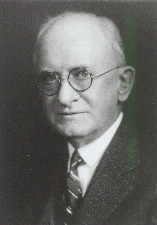
July 1: Joseph Sweetman Ames takes office as fourth president of the university.
October 6: Professor John C. French presides at the dedication of Levering Hall. Basement accommodates cafeteria, kitchens, a soda fountain, student publication offices, and a barber shop. Main floor has lobby paneled in black walnut, a parlor and library on either side, and leads back to a great hall. YMCA conference room, a meeting room, and a faculty dining room are on the second floor.
October 15. Dedication and formal opening of the William H. Wilmer Ophthalmological Institute,which is the first in the U.S. associated with a university. The institute is under the direction of Dr. William Holland Wilmer of Washington, D.C.
1930
President Ames asks Mary Willard Berry, wife of Dean Edward Berry, to establish the Women’s Faculty Club to promote social contacts between faculty members, some of whom live a distance from the Homewood campus. The name of the organization changes after the death of Mary Berry in 1939 to the Mary Willard Berry Club of The Johns Hopkins University. During World War II, members serve as a Red Cross group, as grey ladies, nurses aides, and air raid wardens. Membership in the club is offered to wives of the medical school faculty in 1948. In 1951 the name again changes to the Woman’s Club of the Johns Hopkins University.
April 13: Nineteen memorial windows in the main reading room of Gilman Hall are dedicated to the memory of Francis T. King, one of the first trustees. Given by King’s daughter, Mary King Carey, the windows feature stained glass decorations against a clear background; the designs are printers’ marks and watermarks employed by early printers and paper makers.
October: Walter Hines Page School of International Studies opens on the Homewood campus, with John Van Antwerp MacMurray, U.S. diplomat to China for past five years, as its director. The president’s report notes that the school is a research institution, “not one for students looking for degrees or certificates.”
1931
February 1: Dean Edward Wilber Berry says the Sun that he supports a move to remove Johns Hopkins from intercollegiate sports and have all sports be only intramural. “The degree to which intercollegiate gladiatorial combats have developed in this country and the substitution of the aim of winning for the aim of sport for the sport’s sake have caused both the public and the institution to lose sight of or subordinate the true value of athletics for physical improvement, recreation and training in all the manly virtues — physical, mental, and moral.”

First Turtle Derby run in a large circle on the tennis court with turtles that are descendants of those kept in the early days of the hospital by Benjamin Frisbee, doorman at the hospital from 1889 to 1933. Contestants are released from a large wire sterilizing cage positioned in the middle. The first turtle to cross the line wins. Each department sponsors a contestant and contributes to the purse. First winner was “Sir Walter,” pride of the brain surgeons, who took that year’s cash prize. Races in following years attract several thousand spectators and more than fifty brightly painted, cleverly (and sometimes raunchily) named entries, some of them from Hopkins men in other states or countries. In the 1933 race, a large grey rabbit wanders slowly towards the circle’s edge while “Panic II,” the entry of the Phipps Clinic, trudges steadily outward and wins, thereby reinforcing the lesson of the tortoise and the hare. Future races are broadcast over national radio and featured in newsreels. Proceeds are contributed to charitable causes.
1932
September: Agreement between The Johns Hopkins University School of Hygiene and Public Health and the Baltimore City health department establishes the Eastern Health District in a one-square-mile area of the city near Johns Hopkins Hospital. The district becomes a base for broad public health and research programs conducted with financial support from the Rockefeller Foundation and the U.S. Public Health Service. Public health nurses are trained and graduate students in the School of Public Health gather data for thesis research. Residents of the Eastern Health District are contacted individually and information is gathered on living conditions, general health, and diseases, especially tuberculosis and diphtheria. Child health studies and epidemiological studies on infectious and chronic diseases are an important component of the research. In 1936 Dr. Thomas B. Turner and his staff conduct a study of syphilis that results in papers of national import.
1933
February 24: As the national depression worsens, faculties of philosophy, engineering, public health, and medicine join with administrative officers of the university to voluntarily contribute a portion of their salaries to help avoid a university deficit. The Sunobserves, “The money itself is extremely important to the university at this juncture; but we doubt that even the money will be as important, in the long run, as this demonstration that the members of its staff believe in it so strongly that they are willing to back their belief with hard cash.”
1935
April 12: Students at Johns Hopkins, Morgan, and Goucher hold antiwar meetings on their respective campuses. Largest group is at Hopkins. Thirty Goucher girls march to a rally in front of Levering Hall to protest ROTC and war spending. Demonstrations continue into 1938. Margaret Sparrow, a Goucher student at the time, recalls, “We knew there was a war coming. The ROTC at Hopkins was full. We didn’t go to the peace march. It’s not that we didn’t want peace, but we didn’t want Hitler taking over. The peace marchers made a lot of noise, but they were always in a minority.”
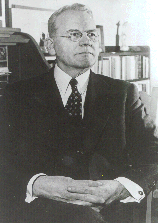
July 1: President Ames retires and is succeeded by geographer Isaiah Bowman.
1940
The Peabody Conservatory receives funding from the Carnegie Foundation to underwrite music training for Baltimore’s public schools. Peabody’s music education department administers the program.
1942
Johns Hopkins sends two five-hundred-bed hospital units to the Pacific during World War II. General Hospital Unit 18 spends two years in Fiji, then moves on to the India-Burma theater. General Hospital Unit 118 is based successively in Australia, Papua, New Guinea, and the Philippines and treats more than forty thousand patients.
1942
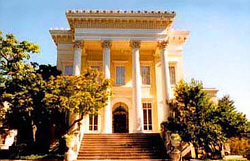
John W. Garrett dies and leaves his home, Evergreen House (about a mile north of the Homewood campus), to The Johns Hopkins University without an endowment. Prior to her death in 1952, his widow, Alice Warder Garrett, establishes the Evergreen House Foundation and bequeaths to it her important collection of early twentieth-century paintings and an endowment, the income from which helps to maintain the house and its programs. Evergreen House is restored in the late 1980s and opens for daily tours to the public and for special cultural and educational programs.
Both Commemoration Day and commencement exercises are canceled. President Isaiah Bowman says elimination of the public events is a “war emergency measure.” Summer classes begin in June as part of the university’s accelerated program during the war.
March 10: Applied Physics Laboratory of the Johns Hopkins University is founded to research and develop a radio proximity fuze (VT fuze) that will explode a warhead near its target. Merle A. Tuve, who has been working on the problem since 1940 for the Carnegie Institution’s Department of Terrestrial Magnetism and the National Defense Research Committee, is APL’s founder and first director. President Isaiah Bowman and university trustees agree to manage the lab and sign a contract with the government’s Office of Scientific Research and Development. Trustee Luke Hopkins becomes the university’s liaison with the laboratory. The lab’s first location is a renovated garage on Georgia Avenue in downtown Silver Spring, Maryland — its used car sign remains as camouflage.
1943
January 5: Gunners aboard the USS Helena south of Guadalcanal fire APL’s new VT fuze at the enemy for the first time. Although there is no way to be sure that the fuze has actually worked as planned, the targets are destroyed and credit is given to the fuze by antiaircraft control officer Commander R. L. Cochrane on the Helena, who says, “I am convinced that both planes were shot down by the influence projectiles because of the phasing of the bursts that were visible.” Later generations of the fuze are used successfully in Europe by U.S. and British forces. A third of the U.S. electronics industry becomes engaged in fuze production and more than twenty-two million are produced.
September 17: Christian A. Herter, Paul H. Nitze, William Yandell Elliott, Joseph C. Grew, Halford L. Hoskins, and John Lockwood (representing the Rockefeller Foundation) meet in Washington, D. C., to discuss the founding of a graduate school in international studies to be based in Washington. Later in 1943, the School of Advanced International Studies (SAIS) is established by the Foreign Service Educational Foundation.
1944
June 14: US Army 3312th Service Unit, ASTP (Army Specialized Training Program), arrives on Homewood campus under the direction of Lieutenant Colonel Harry M. Gwynn. His command includes 344 men at Homewood, 160 students at the School of Medicine, and the ROTC department. Additional men are expected to join. Students take courses in engineering, German, French, and Italian.
October: Classes begin at SAIS in the mansion formerly used by the Gunston Hall School for Girls on Florida Avenue, N.W. Halford L. Hoskins, former dean of the Fletcher School of Law and Diplomacy, is first director.
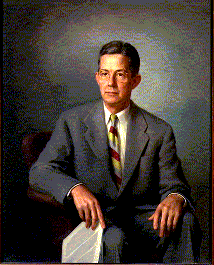
November 29: Dr. Alfred Blalock performs the first “blue baby” operation after careful collaboration with pediatric cardiologist Dr. Helen Taussig and laboratory technician Vivien Thomas. One grateful mother later recalls her son’s surgery, “All of a sudden the rosy complexion of his face struck me. His lips were bright red…. The following day he was sitting up in his bed. The blood circulation in his lungs was fully restored by a miracle of intelligence and skill, intense work, and exacting attention which Professor Blalock and his assistants accomplish every day.” [Learn more about the blue baby operation online.]
1945
APL’s Forest Grove Station in Montgomery County, Maryland, houses equipment that simulate on the ground the conditions faced in the air by APL’s new supersonic ramjet engines.
1946
Conclusion of World War II and passage of GI Bill of Rights creates a huge influx of veterans into the student body. Russell Baker recollects, “My Hopkins career was split by the war, and it was a quite a different place when I came back. Suddenly there were a lot of people there, and most of them were wearing fragments of old military uniforms. Many of them had been in combat. It was a very mature group of people and so much more fun than it had been before. These were people who weren’t impressed by the professors. They were constantly challenging and arguing, and the professors loved it. They hadn’t had such a good time since they were in college.”
Remembering the camaraderie among doctors from the two hospitals during their service in North Africa during World War II, John Boland, dean of Guy’s Hospital medical school in London, proposes to Alan Chesney, dean of the Johns Hopkins School of Medicine, that the two institutions exchange doctors “to maintain the friendship, cooperation, and exchange of ideas which has been one of the better things which has come out of this War.” Alfred Blalock becomes one of the first Hopkins doctors to take advantage of the opportunity and introduces his “blue baby” operations to England. In subsequent years, hundreds of physicians and administrators have participated in the program.
Reginald G. James is the first African American to graduate from Johns Hopkins, earning a Master of Public Health degree from the School of Hygiene and Public Health.
Clifton Wharton is the first African American admitted to the School of Advanced International Studies. In 1970, at Michigan State, he is the first African American to lead a major predominantly white university as president. Eight years later, he is the first African American appointed chancellor of an entire system when he heads the State University of New York (the nation’s largest system) for nine years. He is also the first African American to lead a major foundation (the Rockefeller Foundation in 1982) and the first to be chairman and CEO of a Fortune 500 company, at TIAA-CREF from 1987 to 1993.
February 5: Igor Stravinsky lectures to students and faculty at the Peabody Conservatory.
October 24: The first images showing the curvature of the Earth are made by APL cameras in a V-2 rocket launched at White Sands Proving Ground in New Mexico. The high-altitude research program also determines the intensity of cosmic rays, reveals the nuclear processes at the edge of our atmosphere, and investigates the extent of the solar spectrum.
1947
McCoy College becomes a separate division for evening programs, offering degrees in arts and sciences, business, education, and engineering. The school is named for John W. McCoy, a Hopkins benefactor and Baltimore business and civic leader. By 1959, McCoy College offers a B.S. in nursing in cooperation with the School of Nursing of The Johns Hopkins Hospital.
April 1: APL director Lawrence R. Hafstad establishes the Research Center of the Applied Physics Laboratory to conduct fundamental research in areas of present or potential importance. Over the succeeding years, the Research Center collaborates with The Johns Hopkins Medical Institutions on biomedical research and with the School of Public Health on investigations of the causes, prevention, and control of unwanted fires. In 1979 the Research Center is named to honor President Emeritus Milton S. Eisenhower.
1948
The university establishes the Chesapeake Bay Institute as a joint enterprise of the Chesapeake Biological Laboratory, the Virginia Fisheries Laboratory, and the U.S. Navy.
March 26: The Applied Physics Laboratory becomes a permanent division of the university, underscoring Johns Hopkins’ commitment to research and its application for the public good. Ralph E. Gibson is named director and holds the position until 1969.
December 17: Lynn Poole, the university’s first director of public relations, initiates The Johns Hopkins Science Review, a television program that explains and demonstrates technical ideas for the general public. The first program goes on the air in March 1948 from Remsen Hall with the scientists explaining their work on camera and Lynn Poole acting as the host. The program, which is the first weekly network series produced by a university, becomes a national favorite and wins several prestigious awards before its demise in 1955.
1948-1949
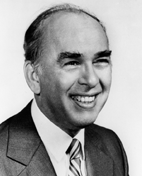
Three strains of the poliomyelitis virus are verified at Johns Hopkins; without this verification, the Salk vaccine could not have been developed. In 1957 three Hopkins scientists, Dr. David Bodian, Dr. Isabel Morgan and Dr. Howard A. Howe, are honored for their work by their election to the Polio Hall of Fame.
1949
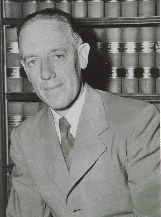
January: Biophysicist Detlev Bronk takes over the presidency of the university when Isaiah Bowman retires.
1950
The School of Advanced International Studies affiliates with The Johns Hopkins University as a graduate division. SAIS’s buildings, library, and equipment are transferred to the university by the Foreign Service Educational Foundation. Philip Warren Thayer remains as dean, a position he has held since 1948.
Frederick I. Scott Jr. is the first African American to earn an undergraduate degree at Johns Hopkins, receiving a bachelor’s in chemical engineering. In 1958, the first three African Americans earn undergraduate degrees from the School of Arts and Sciences. One of them, Ernest A. Bates, becomes a trustee in 1988.
April: Corbin Gwaltney edits the first issue of Johns Hopkins Magazine, which features top quality photographs and stimulating stories geared to alumni and friends of the university, a revolutionary concept for an alumni magazine.
1951
February 22: President Bronk inaugurates a plan that enables students to move at their own pace and breaks barriers between separate disciplines to create a “community of scholars.” Bronk proposes “to make this a university in which the sharp distinction between undergraduates and graduates will be eliminated . . . in which students will be given the opportunity to progress as rapidly as they are able.” Under this New Plan, as it is called, any student may take any course he is qualified for, even graduate level ones. Bachelor’s or master’s degrees will not be required before working for a Ph.D.
1952
December: Owen Lattimore, director of the Walter Hines Page School of International Relations since 1938 (with a leave of absence from 1941 to 1944 to serve as an advisor to Chiang-kai-Shek), is indicted by a federal grand jury on seven counts of perjury following investigations by congressional committees and accusations by Senator Joseph McCarthy that Lattimore is the top Soviet agent in the U.S. University trustees grant Lattimore a leave of absence with pay. Some feel that Lattimore should be fired outright prior to a verdict. The charges against him are dropped in 1955 and Lattimore returns to Johns Hopkins to teach history until 1963.
1953
April 16: The Walter Hines Page School of International Relations at Johns Hopkins closes in a reorganization of the university. President Detlev Bronk says that the closing of the school is an “attempt to simplify Johns Hopkins’ academic structure.”

September: Lowell Reed, recently retired from a distinguished career as a professor of biostatistics and dean of the School of Hygiene and Public Health, takes over as university president when Detlev Bronk resigns to become the first president of Rockefeller University.
1954
The completion of Shriver Hall provides the Homewood campus with its first large auditorium. In 1939 Alfred Jenkins Shriver, a local lawyer, left the university the residue of his estate to build a lecture hall. In accordance with to the conditions of the will, the building’s walls are adorned with murals depicting the Hopkins class of 1891 (Shriver’s class), ten philanthropists of Baltimore, ten famous beauties of Baltimore (as chosen by Shriver), the original Faculties of Philosophy and Medicine, the original trustees of the university and hospital, and Baltimore clipper ships.
The first building at APL’s new site in Howard County, Maryland, is dedicated. Lee A. DuBridge, president of the California Institute of Technology, says at the occasion, “Whenever you find a highly successful group, I suggest you seek the causes for its success not in the organization chart, not in the budget book, not by counting uniforms or rank, but by finding a man or small group of men who have created the spirit of the place and who know how to preserve that spirit.” By 1982 the initial 290-acre-complex has been expanded to 365 acres and APL encompasses one hundred thousand square feet of floor space. Field testing often takes place off-site.
February 22: Johns Hopkins University receives a silver and ebony mace, the gift of the late historian Douglas Southall Freeman, at Commemoration Day ceremonies. Professor C. Vann Woodward makes the presentation to Carlyle Barton, president of board of trustees. The Evening Sun explains that the mace depicts in silver the “role of the arts and sciences in man’s cultural development since ancient times.” The mace will be carried at all future university processions and will be at president’s side during official functions.
1955
February 22: SAIS inaugurates its new campus in Bologna, Italy, as an American graduate school where future leaders of the U.S. and Europe can study together and learn to cooperate, without national bias, toward common goals. C. Grove Haines is the Bologna Center‘s organizer and first director (from 1955 to 1972).
May 11: Ames Hall, the new engineering building, is dedicated by Governor Theodore R. McKeldin, who declares that the structure embodies “the lasting shadow of a series of men whose impact on the university, the state, the nation, and the world will live on beyond their mortal stay on earth.” The building is named for Joseph Sweetman Ames, fourth president of the university, a physicist, and a pioneer in aeronautical science. Ames Hall cost $1.5 million in state-appropriated funds.
1956
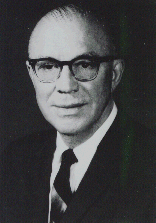
July 23: Milton Stover Eisenhower, brother of the current U.S. president, is elected the eighth president of The Johns Hopkins University.
December 13: Plans are announced for construction of a new house for the university president in the woods at the west end of the botanical gardens on the site called for in the original campus plan. President Eisenhower expresses his pleasure: “I look forward to living on the Homewood campus so I can meet with student and faculty groups for discussions of mutual interests in an informal atmosphere.” In 1972 the residence is renamed Nichols House to acknowledge the generous gift of trustee Thomas Nichols that helped fund its construction.
1957
Washington Center for Foreign Policy Research is established at SAIS for the discussion and study of U.S. foreign policy and theory by both academics and government officials. The center undertakes government-sponsored research projects, holds weekly roundtable discussions with notable guests, and helps attract distinguished academics to the faculty. In 1980 the center is reorganized as the Johns Hopkins Foreign Policy Institute with all SAIS professors as members.
1959
Almost seven thousand students are enrolled in McCoy College, more than twice the combined enrollment of the other divisions of the university.
February 13: The Carnegie Institution of Washington, D.C. announces that it will move its East Baltimore operations — where they have been been for forty- three years — to a new building on the Homewood campus. The Carnegie’s areas of interest have changed over years from anatomy and embryology to more biochemical research.
September 17: Engineers from the Applied Physics Laboratory watch as their first satellite, the Transit 1-A, is launched from Cape Canaveral, Florida, but it does not achieve orbit. The second attempt, the Transit 1-B succeeds on April, 13, 1960 and achieves an orbit, but it takes another year of experiments before an APL satellite reaches its projected orbit on June 29, 1961.
1960
July: William B. Kouwenhoven, professor emeritus and former dean of the School of Engineering, James Jude, a resident in surgery, and Guy Knickerbocker, an electrical engineer and instructor in surgery, report in the Journal of the American Medical Association that they have developed a process to keep the inert or fibrillating heart pumping blood by performing closed chest massage. Professor Kouwenhoven’s defibrillation machine has been in use since 1957, but this new technique will enable trained persons to provide the life-saving therapy without machines or surgery. The procedure becomes known as cardiopulmonary resuscitation, or CPR.
July: Hundreds of children on the East Coast catch fireflies for researchers at McCollum-Pratt Institute. The scientists are interested in the two chemicals that produce light in the fireflies, luciferin and luciferase, which also influence the energy output of cells. Hopkins researchers hope to obtain a million bugs this year and is sending the chemicals to labs all over the world. Children receive thirty cents for every one hundred fireflies they deliver. Ten-year-old David Vogel says, “Of course the money makes a difference, but mostly I just like going out there and catching ’em.”
1961
April 27: A modern five-story building for the Bologna Center of SAIS is dedicated on Via Belmeloro, a short distance from the center’s original building. President Milton Eisenhower, SAIS dean Francis O. Wilcox, and the past and present rectors of the University of Bologna participate in the ceremonies.
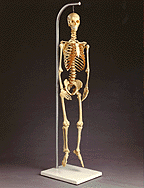
November: The Johns Hopkins University Press “publishes” the work that will become a bestselling release in subsequent years: an eighteen-inch plastic replica of a human skeleton that quickly gains the moniker “Mr. Bones.” The likeness is the result of three years of painstaking work by Leon Schlossberg, a renowned medical illustrator on the faculty.
1962
McCoy College introduces a master of liberal arts program for adults seeking to broaden their knowledge, perspective, and insights through studying the great ideas of civilization. The program draws lecturers from the Faculty of Philosophy as well as leading experts from cultural and other academic institutions in the region. The M.L.A. program is the first of its kind and is widely copied by other colleges and universities. In 1999 the program moves to the School of Arts and Sciences.
1963
McCoy College establishes an educational center at APL. Advanced technical courses leading to a degree have been taught at APL since 1958; the new center recognizes their popularity. The faculty is drawn largely from APL staff, but the students are generally not APL employees. In 1982, the APL Center comes under the auspices of the Whiting School of Engineering.
May: The Maryland Department of Education authorizes the Peabody Conservatory of Music to grant the doctor of musical arts degree. Students have been enrolled in the program since the fall of 1962.
October: The School of Advanced International Studies moves to its new eight- story building at 1740 Massachusetts Avenue N.W. President Milton Eisenhower actively solicited funding for the building, which came largely from the Ford and the Rockefeller Foundations. In 1986 the building is named to honor founder and trustee Paul Nitze and his wife for their “lifelong dedication to public service, to education, and to SAIS.”
1964
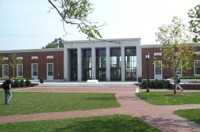
November 7: The new university library is formally dedicated. It is large enough to house library collections from across the campus and provide space for future acquisitions. To keep the enormous building from overwhelming the older, small buildings on campus the architects place four and a half of the structure’s six levels underground. The following April, university trustees vote unanimously to name the library for President Milton Stover Eisenhower.
1965
McCoy College becomes the Evening College and Summer Session. The name change reflects a shift in continuing studies to graduate programs in response to the changing requirements of students because community colleges now fill the needs of most part-time undergraduates.
1966
The School of Arts and Sciences is created by the merger of the School of Engineering Sciences and the Faculty of Philosophy.
The Peabody Library becomes a department of the Enoch Pratt Free Library system.
1967
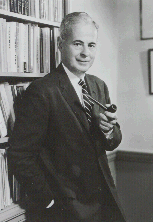
July 1: Former ambassador to Brazil and Assistant Secretary of State Lincoln Gordon assumes the presidency of the university when Milton Eisenhower retires.
July 28: Johns Hopkins’ new oceanographic vessel, Ridgely Warfield, named for the former director of the Institute for Cooperative Research, is christened. Funding for the 106-foot catamaran comes in part from National Science Foundation and its operation is supported by the Office of Naval Research. A crew of seven and eleven scientists can live aboard for thirty days away from land. Hopkins teams plan to use the vessel to study problems associated with the spectrum of motion in the ocean. Don Pritchard of the Chesapeake Bay Institute says, “If we’re ever going to understand how the ocean responds to forces driving it, we must understand this motion.”
1967-68
The university’s student-operated radio station, WJHU-AM, broadcasts to dormitory residents for 235 days during the 1967-68 academic year. Programs include coverage of all away football and lacrosse games. During the riots in early April 1968 that follow the assassination of Martin Luther King Jr., the station remains on the air for almost sixty continuous hours to keep students informed with news bulletins and police and university announcements. The station, still run by students, switches to FM in 1979. In 1985 the university converts WJHU-FM to a professionally operated National Public Radio member station.
1968
The Center for Urban Affairs opens. Precursor to the Institute for Policy Studies, it focuses on addressing social problems through research and teaching.
May: The News-Letter announces the formation of the Black Students Union, “an informal coalition of Negro students” who want more black freshmen admitted (and more representation in the admissions office), and more black professors. Spokesmen Bruce Baker and John Guess say the association will “attempt to deal on the student level with the problems of race relations at Hopkins and within the Baltimore community.”
1969
May: Committee on Coeducation assembled by President Lincoln Gordon submits its majority report recommending that “coeducation at the undergraduate level be instituted without delay, that is, by the fall of 1970.” The report suggests that coeducation will increase the potential pool of applicants from which to choose students, increase student body diversity currently biased toward natural sciences, improve the intellectual and social environment, and stop the discrimination that denies admission to qualified women. “The committee also believes that undergraduate coeducation is economically feasible as well as educationally desirable.”
October 30: The Academic Council recommends that women be admitted to the undergraduate divisions of The Johns Hopkins University by September and the trustees make the policy official with a formal resolution on November 10.
October 15: In a call for a “Vietnam Moratorium,” some three thousand people gather on the Homewood campus for a rally before marching downtown. A Student Council resolution asks President Gordon to officially close the university for the day. Gordon refuses, saying “to suspend operation would violate the institutional neutrality of the university on matters of public policy.”
1970
April 16-23: Students hold demonstrations to protest the presence of military recruiters on campus. President Gordon offers to hold a referendum on the issue. Administrators secure a court injunction forbidding the occupation of campus buildings and other disruptions of university activities. Students hold a vigil on the lawn in front of Homewood House and some faculty join students in a two-day strike of classes. An agreement between administration and students ends the strike on April 23. The administration agrees to suspend recruitment until a referendum of full-time students and faculty is held.
April 30: Seventy percent of those eligible to vote participate in the referendum. Vote is 1183 against recruitment, 1121 for reinstatement of recruitment.
May 5: A memorial service is held for students killed at Kent State University.
September: The first full-time female undergraduates — transfer students and freshmen who can commute from home — arrive on campus.
1971
March 12: President Lincoln Gordon submits his resignation; Milton Eisenhower assumes the position as interim president on April 5. On the same day Steven Muller, the recently appointed provost, assumes his new post. The prevailing opinion is that the budget deficit will be Eisenhower’s biggest challenge and he calls a university-wide faculty meeting to urge the restoration of fiscal integrity.
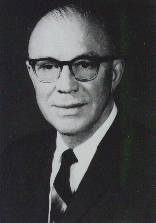
President Milton Eisenhower lends his support to the formation of a credit union to benefit faculty and staff. On May 14th, in accordance with Federal Credit Union membership regulations, seven members each deposit five dollars into an account at the Maryland Credit Union League. The Johns Hopkins Federal Credit Union becomes fully operational on October 1, 1971, when the payroll deduction system goes into effect. Closing statement for the first year shows 744 members and assets of fifty-one thousand dollars. By 2000, there are over twenty-three thousand member accounts with assets of more than $99 million, making it one of the largest credit unions in Maryland.
As director of the Centennial Planning Office, electrical engineering professor emeritus Ferdinand Hamburger Jr. recognizes the university’s need for an archival repository and oversees the establishment of what is later named the Ferdinand Hamburger Jr. Archives in the special collections department of the Eisenhower Library. The Hamburger Archives is the official archival repository for all Homewood divisions as well as for the Paul H. Nitze School of Advanced International Studies.
1972
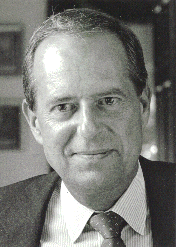
February 1: Steven Muller takes office as president of the university. Later in year, he also becomes president of The Johns Hopkins Hospital, the first person to hold both offices since Daniel Coit Gilman. Muller relinquishes the hospital presidency in 1983.
Spring: Students mount a festival they call 3400 on Stage on the Homewood campus. In subsequent years event becomes known as Spring Fair.
October: New women’s locker room opens in the Newton H. White Jr. Athletic Center. Undergraduate women on campus now number 375.
1973
February: President Steven Muller announces the launch of an ambitious capital campaign to raise $100 million for The Johns Hopkins Institutions. In 1976, as the university celebrates its centennial, national chairman Alonzo G. Decker Jr. announces the successful end of the Hopkins Hundreds campaign that has raised $108.9 million.
The last class in the hospital’s School of Nursing graduates. The Johns Hopkins School of Health Services attempts to revive nursing education in 1975, but the school closes in 1979.
The Evening College opens a satellite branch at Columbia, Maryland. Almost three hundred students enroll in the eleven courses offered at the new site. Over the next twenty-five years the Columbia Center moves three times to ever-larger quarters to better serve a growing demand for part-time graduate education in the greater Baltimore/Washington region.
February 22: The Milton Stover Eisenhower Medal for Distinguished Service is presented to G. Wilson Shaffer. Shaffer received his B.A. and Ph.D. degrees from Hopkins. The citation notes his vigorous support for student athletics. “He installed an imaginative program of physical education” in 1934 and was a staunch advocate of free admission to athletic events. Shaffer founded the Psychological Clinic in 1936. He became dean of the College of Arts and Sciences in the 1940s and was appointed dean of the Homewood Schools in 1948. “Because of his effective, untiring, and intelligent efforts, the university is tremendously indebted to him.”
1974
March 7: Fifteen naked students streak around the Homewood campus and through the Eisenhower Library. A few nights later about three hundred people watch a well-publicized “Streak for Cancer” that raises four hundred and fifty dollars. The new Hopkins Cancer Research Center turns down the money but the American Cancer Society happily accepts it. Faculty members express hope that a noon-time streak through the Johns Hopkins Club will occur soon.
1975
April: University trustees adopt the third balanced budget in a row. Severe cuts (especially in the administration), tuition increases, state aid, and the generosity of donors help to achieve the goal of fiscal stability. President Muller asks the faculty to consolidate overlapping academic programs.
September 10: President Emeritus Milton Eisenhower speaks at opening ceremonies for The Johns Hopkins University’s centennial celebration at Homewood.
1976
February 20-22: Centennial celebrations include symposia on expansive themes such as cosmology, the responsibilities of the critic, international health, and the impact of natural sciences on society. Northrop Frye, Linus C. Pauling, and S. I . Hayakawa are among the speakers. The Baltimore Symphony Orchestra performs of “A Song of Celebration,” composed by alumnus Hugo Weisgall with lyrics by poet John Hollander at a special concert at the Lyric.

May 21: Dr. Helen Brooke Taussig receives the Milton Stover Eisenhower Medal for Distinguished Service at the centennial commencement ceremony. The citation notes her part in kindling the idea for the “blue baby” operation that “provided the impetus for cardiac catheterization and, eventually, open-heart surgery.” The citation concludes, “the astounding progress of cardiac surgery in the last thirty years began with Taussig and Blalock.”
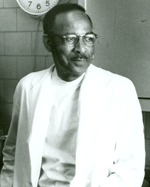
Vivien T. Thomas, another prominent member of the “blue baby” team, is honored with a doctor of laws degree. Thomas was Dr. Alfred Blalock’s laboratory technician for many years and “earned a reputation as an outstanding surgical assistant and research associate, contributing ideas as well as operative and manipulative techniques,” according to the citation that accompanies his honorary degree. During the first “blue baby” operation in 1944 “he stood behind Dr. Blalock as the operation proceeded, offering suggestions and answering questions put to him by Dr. Blalock.” [Learn more about the blue baby operation online.]
1977
July: The Johns Hopkins University and the Peabody Institute formally affiliate after a century of friendly associations. Peabody faculty member Leon Fleisher recalls, “The fact that Hopkins extended its umbrella over our sodden heads was a sign that we had a value to an institution as far-reaching and powerful as Hopkins. It gave us security. Everybody’s heads were lifted and backs were straighter. Hopkins has been most judicious in the affiliation. They’ve not tried to impose or micromanage. And I think that Hopkins has benefitted also. Students from Hopkins come to study at Peabody. It’s a recognition that music is one of those human activities that most ennoble the spirit, which I think is one of Hopkins’ goals.”
1978
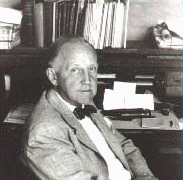
May 17: The Alan Mason Chesney Medical Archives is dedicated in conjunction with a special meeting of The Johns Hopkins Medical History Club. The archives is named to honor the author of a three-volume history, The Johns Hopkins Hospital and The Johns Hopkins University School of Medicine: A Chronicle.
September: SAIS graduates Hermann Eilts, ambassador to Egypt, and Samuel Lewis, ambassador to Israel, are members of the U.S. delegation headed by President Jimmy Carter during negotiations that lead to the Camp David Accords.
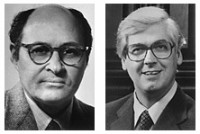
October: Daniel Nathans and Hamilton Smith, professors of microbiology at the School of Medicine, are awarded the Nobel Prize in Medicine or Physiology for their work on site-specific restriction enzymes (with Swiss microbiologist Werner Arber). Their work paves the way for future research to decipher the construction and function of genes. TheNews American congratulates the Nobel laureates and their colleagues, “That this is a community of great intellectual ferment and excitement is amply proved by the honor accorded these men and the Hopkins.”
1979
The G. W. C. Whiting School of Engineering is established as Johns Hopkins University’s first named division with a gift from the estate of George William Carlyle Whiting, co-founder of the Whiting-Turner Contracting Company. Engineering studies gain momentum from the restoration of a separate division.
Professor Julian Stanley founds the Office of Talent Identification and Development, renamed the Center for Talented Youth in 1981. Its mission is to provide encouragement to highly able pre-collegiate youth by engaging them in programs that provide academic stimulation.
May: Women’s Medical Fund Memorial Building is torn down to make way for a modern preclinical teaching center. The building, the first devoted to the School of Medicine, was built in 1894 to house the anatomy department.
1980
SAIS Student Association requests that the division’s commencement ceremony be held in Washington instead of Homewood.
1981
April 30: The university signs a $40-million contract with NASA and AURA (Association of Universities for Research in Astronomy, Inc.) to establish the Space Telescope Science Institute at Homewood. The institute will become the world center of research in optical astronomy where scientists will receive information from the space telescope transmitted to them from the Goddard Space Flight Center.
1982
An exhibition entitled American Impressionism, organized by the Smithsonian Institution Traveling Exhibition Service features paintings from the Peabody’s collection. The exhibition opens in Paris and travels to cities in Eastern Europe.
July: The Peabody Library officially becomes the George Peabody Collection of The Johns Hopkins University and leaves the Enoch Pratt Free Library system, which had managed the library when the Peabody could not afford its maintenance.
1983
The Johns Hopkins University School of Nursing opens as a degree-granting division, fulfilling the school’s long-held dream of university affiliation. The first year is used for staff and student recruitment and planning. Twenty-eight students are admitted in September 1984.
The School of Public Health and SAIS establish a three-year program in international health services.
October 8: The newly renovated Miriam A. Friedberg Concert Hall is dedicated at the Peabody Conservatory. Sidney Friedberg funded the renovations as a memorial to his wife, whom he had met while they were both students at Peabody.
December 13: A rally at Levering Hall calls for the renewal of a campaign to have the university convert the Applied Physics Laboratory to non-military research. Speakers included Professor Emeritus Jerome Frank and Chaplain Chester L. Wickwire. Leaders of the movement say that development of nuclear weapons is contrary to the humanitarian traditions of the university and a threat to humanity. Edward L. Cochran, assistant director at APL, says that by and large APL’s programs are not nuclear and are more in the nature of fleet defense.
1984
The Dome Corporation is established as a for-profit joint venture of the university and the Johns Hopkins Health System. Dome is involved in venture management and develops property around the hospital.
Johns Hopkins Hospital acquires the Baltimore City Hospital on Eastern Avenue, which for a time is named the Francis Scott Key Medical Center, but becomes known as the Bayview research campus.
The Evening College and Summer Session becomes the School of Continuing Studies.
1985
The School of Medicine drops the Medical College Admissions Test as a requirement for applicants in an effort to encourage students to pursue broader educational opportunities before entering medical school.
The Peabody reaches its $12 million goal in its first fundraising campaign after its affiliation with Johns Hopkins.
June 17: The School of Continuing Studies announces that it will revive its master of arts in teaching program for science teachers. The M.A.T. program had begun in 1950s with the support of the Ford Foundation.
October 20: The university reveals plans for a $209-million expansion in its facilities. The program will add six new buildings, upgrade dormitories, install a computer network, and expand classrooms and laboratories. Construction will take place at Homewood, in East Baltimore, and at APL. SAIS and Peabody will acquire and renovate existing buildings. The work is to be financed by a bond issue.
1986
September 10: The Hopkins-Nanjing Center for Chinese and American Studies opens in a new building constructed for that purpose on the campus of Nanjing University in the People’s Republic of China. The center has been established as a joint partnership between the two universities with the intention of training an equal number of American and Chinese postgraduate students each year in economics, history, political science, and international relations. The American aspect of the center is administered by SAIS.
1987
Spring: SAIS acquires more office and classroom space as it moves into a second building on Massachusetts Avenue. The newly acquired building is named for Benjamin T. Rome, a generous benefactor to the school.
Spring: The School of Continuing Studies opens its Downtown Center to accommodate the growing number of professionals in downtown Baltimore seeking advanced degrees and enhancement of their skills and training. The center has eight classrooms, two computer labs, an executive conference room, and a 222-seat auditorium, as well as an on-site library, bookstore, and academic advising services.
The Institute for Policy Studies, devoted to solving social problems through research and teaching, opens on the Homewood campus. In 1992, the institute begins awarding masters of arts degrees.
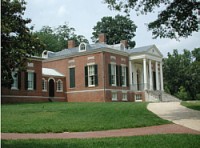
Following twelve years of meticulous research, an archaeological excavation, and a full-scale restoration, Homewood House, one of the finest Federal residences in America, is reopened to the public as s museum. Homewood’s collections of fine eighteenth- and nineteenth-century furnishings and decorations include pieces originally owned by the Carroll family. The house was built by Charles Carroll of Carrollton, the last surviving signer of the Declaration of Independence, as a wedding present for his son Charles Jr. and Harriet Chew of Philadelphia. The restoration was funded by Robert G. Merrick, who had lived in the house while a graduate student.
November: The Peabody Symphony Orchestra performs at Tchaikovsky Hall and the Hall of Columns in Moscow.
1988
September 26: The Montgomery County Center in Rockville is established to allow executives in high-tech industries the opportunity to earn advanced degrees part-time. Engineering, arts and sciences, business, public health, and education courses are offered.
December 6: Janus, the Eisenhower Library’s online catalog, is demonstrated to students, faculty, and staff. Horizon, a graphical-based program, replaces Janus on January 1, 1998.
1990
The George Peabody Medal, the highest honor granted by the Peabody Institute, is awarded to outgoing resident Steven Muller, “for his immeasurable contribution to the renaissance of Peabody as one of the top conservatories of music in the world.”
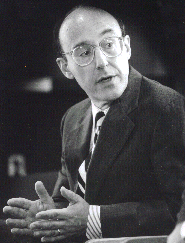
July: William C. Richardson takes office as the university’s eleventh president. Former board chairman Morris W. Offit recalls, “We had enormous financial problems in the late ’80s and early ’90s. The crises forged a bond among us because we had to work very hard. We worked through it and we did it not only efficiently and very professionally, but with dignity. Bill Richardson was probably the best crisis manager in the country. We could not have had a better president at that particular time. He worked eighteen hours a day, seven days a week. There were lot of complaints that he only gave Hopkins five years. I think he gave Hopkins ten years, considering the amount of work that he did. I have nothing but enormous respect for Bill Richardson’s contribution.”
Lieutenant Governor Melvin A. “Mickey” Steinberg, announces that the state will give $15 million to the Peabody if the institute can raise the same amount by September; the goal is reached. As part of a five-year aid package, the state acquires Peabody’s art collection for the people of Maryland.
Rowland Hall is renamed for Zanvyl Krieger, who provided a large donation to renovate the building for the Krieger Mind/Brain Institute, after the physics department moved to the Bloomberg Center. The Mind/Brain Institute, first proposed in 1987, brings together scholars and researchers from multiple disciplines to promote a synthesis of experimental and theoretical studies of the way in which the human brain controls and initiates human behavior. Krieger Hall also houses the Departments of Mathematics and Cognitive Science and Homewood Academic Computing.
Johns Hopkins establishes the Genome Database (GDB) and becomes the central repository for genomic mapping of data resulting from the Human Genome Initiative, a worldwide research effort to analyze the structure of human DNA and determine the location and sequence of the estimated one hundred thousand human genes. The GDB stores and curates data generated worldwide by researchers engaged in the mapping effort of the Human Genome Project. GDB’s mission is to make available to scientists an encyclopedia of the human genome that is being constantly revised and updated to reflect the current state of scientific knowledge. In 1999 the Bioinformatics Supercomputing Centre at The Hospital for Sick Children in Toronto, Ontario, Canada, assumes the management of the GDB.
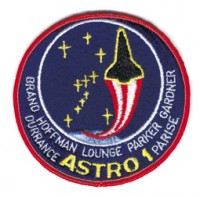
December: Hopkins astrophysicist Sam Durrance flies on the space shuttleColumbia with the Hopkins Ultraviolet Telescope that features diffraction gratings like those originally devised by Henry A. Rowland, the university’s first professor of physics. The telescope gathers information in the far ultraviolet portion of the electromagnetic spectrum of hundreds of distant astronomical objects. More than two dozen faculty, staff, and students are involved in the HUT project, which was conceived by astrophysicist Arthur F. Davidsen of the Department of Physics and Astronomy. During the flight, Davidsen’s team monitors Durrance’s progress at the NASA Marshall Space Flight Center in Huntsville, Alabama. Durrance flies a second HUT mission in March 1995.
1992
June: Chesapeake Bay Institute and its field laboratory near Shady Side, Maryland, close because of budget cuts.
1993
June 23: The Peabody Inn opens in four restored townhouses that provides lodging for an Elderhostel program that draws four thousand people annually for courses in music and dance.
1994
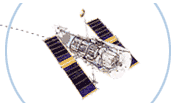
Astronomers from across the nation gather at the Space Telescope Science Institute to watch pictures of the collision between comet Shoemaker-Levy 9 and Jupiter taken by the Hubble Space Telescope.
Business faculty develop the nation�s first graduate credit program for senior managers in law enforcement.
September: Campaign chairman Michael R. Bloomberg announces The Johns Hopkins Initiative and its goal to raise $900 million; one third of this amount has already been pledged.
November: For the first time in the 101-year history of the School of Medicine, this years’ incoming class of 120 students includes more women than men. According to Catherine DeAngelis, vice dean for academic affairs and faculty, women compose forty-three percent of last year’s class and fifty-three percent of this year’s. About thirty percent of the medical faculty are women, slightly above the national average.
November: Jerome A. Alston, Helen Holton, and Blair V. Johnson, students in the School of Continuing Studies’ graduate business program, win a national student case-study competition sponsored by the National Black MBA Association in San Francisco.
1995
The Johns Hopkins University Press launches Project MUSE in collaboration with the Milton S. Eisenhower Library to offer the full text of the press’s scholarly journals via the world wide web. By 1999 MUSE publishes online forty-six JHUP titles in the humanities, social sciences and mathematics.
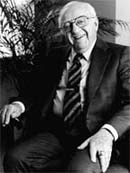
The School of Arts and Sciences is named to honor alumnus Zanvyl Krieger, who committed $50 million for the endowment, the largest gift at that time in Johns Hopkins’ history.
The Phoebe R. Berman Bioethics Institute at Johns Hopkins is created to examine bioethical questions and policy issues.
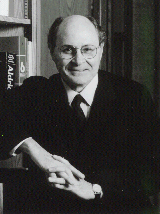
May 31: William C. Richardson leaves Johns Hopkins University to become president and CEO of the W. K. Kellogg Foundation. He is succeeded by Daniel Nathans, Nobel laureate and professor of molecular biology and genetics, as interim president.
July: The Harry and Jeanette Weinberg Foundation pledges $20 million to the hospital to support construction of a new cancer treatment center. The new facility opens in 2000 and is named in the Weinberg’s honor.
October 1: The School of Arts and Sciences is named to honor alumnus Zanvyl Krieger, who has committed $50 million in an effort to increase the endowment of the school.
December 4: The Applied Physics Laboratory announces the establishment of the Institute for Advanced Science and Technology. The new institute builds on the thirty-year association between The Johns Hopkins Medical Institutions and APL that has seen the development of more than a hundred specialized medical devices, including rechargeable pacemakers and implantable medication-dispensing systems.
1996
June 6: Groundbreaking for School of Nursing’s new building takes place on Wolfe Street across from the hospital. With fifty-seven thousand square feet of usable space, the Anne M. Pinkard Building nearly doubles the amount of space available to the school before the new facility’s opening in January 1998.
September: A center for Central Asian Studies will open at the Paul H. Nitze School for Advanced International Studies in Washington. The center will concentrate on six historically Muslim republics in a core area bounded by Turkey, Iran, Afghanistan, and Russia.
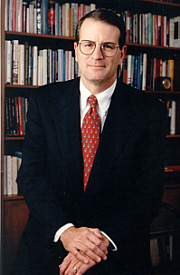
September 1: William R. Brody takes office as thirteenth president of Johns Hopkins University. From 1987 to 1994, Dr. Brody was Martin Donner Professor and director of the Department of Radiology, a professor of electrical and computer engineering, and a professor of biomedical engineering at the university. During the same period, he was also radiologist-in-chief at The Johns Hopkins Hospital.
September: G. W. C. Whiting School of Engineering offers a minor in entrepreneurship and management to give students business and management training in addition to their engineering courses. “I think we’re answering what seems to be the loud and clear message that’s coming from the engineering community. We’re near the leading edge on this,” Roger Westgate, Associate Dean for Academic Affairs, tells a professional journal.
1998
Peabody Ventures, a for-profit company headed by Dr. Geoffrey Wright, is established to market intellectual properties developed by the Peabody computer music department.
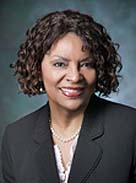
Fannie Gaston-Johansson is named full professor with tenure in the School of Nursing. This appointment makes Gaston-Johansson the first African American woman to have both tenure and a full professorship at the university.
September: After a seventeen-year restoration, the magnificent Renaissance tapestry Scipio’s Triumphal Entry into Rome is rehung in the Peabody’s renovated North Hall, now the Leith Symington Griswold Hall.
October: University board chair Michael R. Bloomberg announces a gift of $45 million to the Johns Hopkins Initiative which, combined with his previous commitment of $55 million, brings his total to $100 million, the largest benefaction in Johns Hopkins’ history.
1999
An independent economist’s analysis shows that Johns Hopkins and its affiliates generate $2.41 billion in net new income in Maryland this year. Spinoff spending adds an additional $2.74 billion for a net impact of $5.15 billion on the economy of the state.
Hopkins researchers receive fifty-six patents and file for an additional 199. Fourteen new companies have been created in Maryland to commercialize on Hopkins inventions.
February 5: The School of Professional Studies in Business and Education renews Hopkins’ commitment to downtown Baltimore by signing a lease as the sole tenant of a new facility in the former Hamburger’s building at Charles and Fayette Streets. The graduate division of business and management will consolidate its classroom and office space at the new facility, which is expected to open in January 2001.
May: The School of Public Health receives a commitment of $20 million from the Bill and Melinda Gates Foundation to create an institute for population and reproductive health.
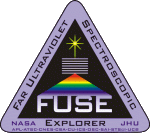
June 24: Scientists in mission control at the Bloomberg Center on the Homewood campus direct the launch of the Far Ultraviolet Spectroscopic Explorer that they designed for NASA. More than four hundred Hopkins employees crowd into Schafler Auditorium to watch a broadcast of the liftoff in Cape Canaveral, Florida.
December 31: Peabody Artist-in-Residence Forrest Tobey conducts a “Virtual Orchestra” in the world premier of “Anthem for the Millennium” by Whiting School of Engineering and Peabody graduate Charles Kim during the countdown to midnight in New York’s Times Square. [Listen to the “Anthem for the Millennium.”]
2000
February 14: Near Earth Asteroid Rendezvous (NEAR) succeeds as the spacecraft, developed and operated for NASA by the Applied Physics Laboratory, enters its orbit around Eros, an asteroid named for the Greek goddess of love. Kishin Moorjani observes, “This is a tremendous feather in the cap of the space scientists at APL. It’s absolutely breathtaking to see something that was fired off from this little Earth so far ahead of time rendezvous with an asteroid hundreds of millions of miles away. It gives you great faith in the laws of physics — and great admiration for the people who do this sort of work, from the people who calculate these orbits to engineers and scientists who actually put the equipment together. What we learn from this will have a great effect on our knowledge of the way the universe came about.”
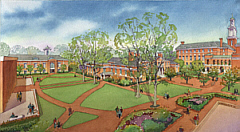
March: The Johns Hopkins Center for Gun Policy and Research, established in 1995 at the School of Public Health, plays a significant role in the Maryland legislature’s passage of the Responsible Gun Safety Act.
After a year’s work and input from literally hundreds of people, a new master plan for Homewood is adopted, intended to guide campus development and construction for decades. An anonymous donor jump starts implementation of the plan, financing a six-month blitz on twenty-four acres of open space in the heart of campus. New brick, marble, and granite paths replace asphalt roads and walkways; cars and trucks are diverted from the center of campus. The result: a safer, more functional, more serene, and far more attractive Homewood.
June: The Johns Hopkins Initiative fund-raising campaign ends June 30, 2000, after attracting $1.52 billion in commitments that nearly doubled the university’s number of named scholarships and fellowships, endowed 130 professorships and two deanships and modernized Hopkins facilities for patient care, research, teaching and student life.
2001
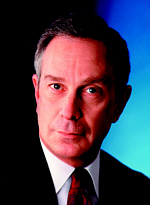
April: The university renames its School of Hygiene and Public Health in honor of alumnus and media entrepreneur Michael R. Bloomberg, recognizing his unprecedented commitment of energy and financial support to the school and the entire university.
May: An anonymous donor pledges $100 million to the Johns Hopkins University Bloomberg School of Public Health for a 10-year effort to rid the world of malaria by developing a new vaccine and drugs. The gift — the university’s largest ever for a single purpose — will establish the Johns Hopkins Malaria Institute.

July: Maryland Public Radio Corp., a community-based non-profit group, signs a letter of intent to purchase WJHU-FM from The Johns Hopkins University.
October 12, 2001: The final major celebration in the Johns Hopkins University’s 125th anniversary year is a ceremony marking the installation of a time capsule in Gilman Hall. The time capsule includes mementoes of the 125th anniversary year. It will be reopened in 2076, the bicentennial of the university and the tricentennial of the United States.
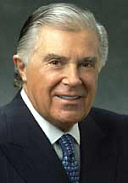
November: The university announces that Sidney Kimmel, founder and chairman of Jones Apparel Group, has donated $150 million for cancer research and patient care — the largest single gift ever to the university. The cancer center is renamed the Sidney Kimmel Comprehensive Cancer Center at Johns Hopkins.
2002
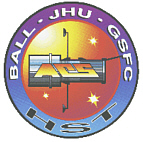
March: NASA’s fourth servicing mission for the Hubble Space Telescope lifts off on Space Shuttle Columbia on March 1. The crew gives the orbital observatory a series of midlife upgrades that includes the Advanced Camera for Surveys (ACS), developed by a team led by Johns Hopkins astronomer Holland Ford. The new instrument package increases Hubble’s already formidable capacity for discoveries tenfold, Ford says.
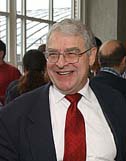
Riccardo Giacconi, professor of physics and astronomy, is awarded the Nobel Prize in Physics.
A Proteomics Center opens at the School of Medicine, focusing on what proteins made by genes do, the next step in realizing the potential of genetic medicine.
May: The Johns Hopkins Institutions announce a $2 billion goal for a new fund-raising campaign to build and upgrade facilities on all Johns Hopkins campuses, to strengthen endowment for student aid and faculty support, and to advance research, academic and clinical initiatives.

June: President George W. Bush names faculty member, alumnus and former dean of public health D.A. Henderson, MD, MPH, as one of 12 recipients of the Presidential Medal of Freedom, the nation’s highest civilian honor.
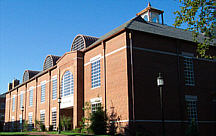
October: Hodson Hall opens at Homewood. “Hodson Hall sets the standard for how universities are going to operate in the future,” said William R. Brody, president of the university. “Every room is wired, and where we can’t wire, there is wireless access, so you can be immediately connected to the Internet.”
2003
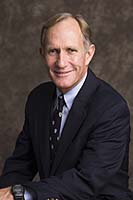
School of Medicine professor Peter Agre is awarded the Nobel Prize in Chemistry.
The Center for Africana Studies is established in the Krieger School of Arts and Sciences in order to pursue broad inquiry into the ideas and experiences of African peoples throughout the world.
2005
The university’s Baltimore Scholars Program begins, providing free tuition for undergraduate study to graduates of the city’s public schools. [Learn more about the Baltimore Scholars Program online here.]
2006
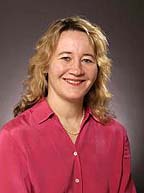
Carol Greider shares the Albert Lasker Award for Basic Medical Research — often called “the American Nobel” — with two former colleagues for discovering telomerase, an enzyme that plays a major role in cancer growth and aging.
2007
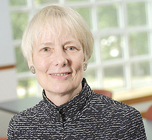
Pamela Flaherty, a trustee since 1997, is elected the 15th chair of the university’s board of trustees. Flaherty is the first woman to chair the university’s governing board and the first graduate of its Nitze School of Advanced International Studies to hold the position.
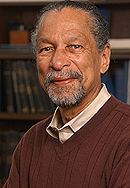
James West, a Johns Hopkins engineering faculty member who, while at Bell Labs, co-invented the microphone used in most telephones and many other electronic devices worldwide, is named a recipient of National Medal of Technology, one the nation’s highest honor for technological innovation.
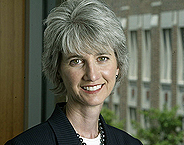
Kristina Johnson, dean of Duke University’s Pratt School of Engineering, is appointed Johns Hopkins’ provost and senior vice president for academic affairs. An electrical engineer with numerous patents and co-founder of several start-up companies, she becomes the university�s 12th provost and the first woman to hold Johns Hopkins’ second-ranking position.
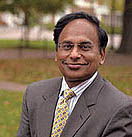
Yash Gupta is named the first dean of the university’s Carey Business School, which launched on the strength of a $50 million gift from trustee emeritus William Polk Carey through his W. P. Carey Foundation.
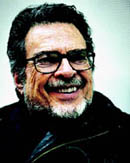
Pianist and Peabody faculty member Leon Fleisher receives the Kennedy Center Honors Award — one of the nation’s highest artistic tributes — for a lifetime of contributions to American culture through the performing arts.
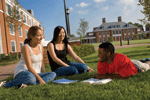
The university completes the Alonzo G. and Virginia G. Decker Quadrangle, the largest construction project on the Homewood campus since the Wyman and Keyser quads were built.
2008

Pediatric neurosurgeon Benjamin Carson of the School of Medicine receives the nation’s highest civilian award, the Presidential Medal of Freedom, in a White House ceremony.




















